Paul van Yperen's Blog, page 302
July 17, 2017
Anne Golon (1921-2017)
On 14 July 2017, French author Anne Golon (1921-2017) passed away. She and her husband Serge were well known for a wildly popular series of historic novels about an irresistibly beautiful and untamable heroine called Angélique. With more than 150 million copies sold in 45 languages, Angélique is one of the most successful book series of the 20th century. During the 1960s, director Bernard Borderie adapted the novels into a series of five films featuring Michèle Mercier as Angélique.
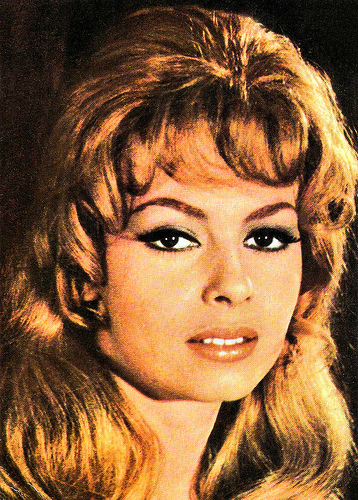
Vintage card. Photo: publicity still for Angélique, marquise des anges/Angélique (Bernard Borderie, 1964) with Michèle Mercier .
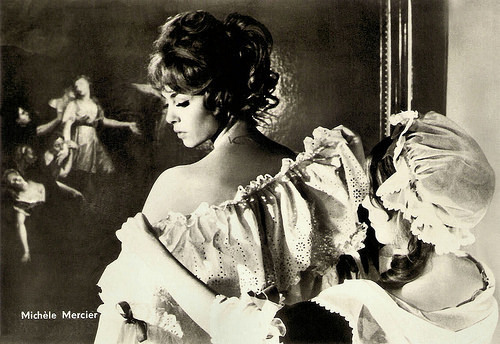
Michèle Mercier . East-German postcard by VEB Progress Film-Vertrieb, Berlin, no. 25/71, 1971. Retail price: 0,20 DM. Photo: Progress.
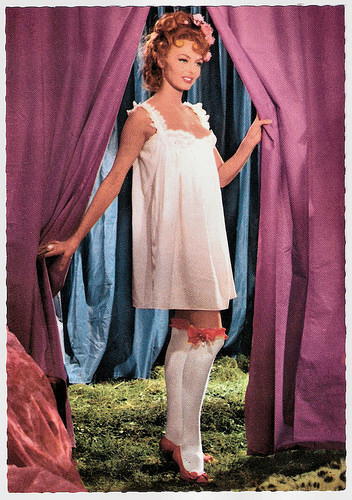
West-German postcard by ISV, no. H-137. Photo: publicity still for Angelique et le roy/Angélique and the King (Bernard Borderie, 1965).
An Overnight Success
Anne and Serge Golon published a series of 13 French historical adventure books on Angélique. In fact, Anne Golon is the author and her husband Serge did much of the historical research. International publishers published their books with as the authors name Sergeanne Golon
Anne was born Simone Changeux in Toulon, a port in south-eastern France, in 1921. She was the daughter of Pierre Changeux, a scientist and a captain in the French Navy. She was interested in painting and writing from early childhood and published her first novel, The Country from behind my Eyes, when she was 18 under the pen name Joëlle Danterne.
During World War II Anne travelled via bicycle through France to Spain. She wrote using different pen-names, helped to create France Magazine, and was awarded a literary prize for The Patrol of the Saint Innocents.[4]
She was sent to Africa as a journalist, where she met Vsevolod Sergeïvich Goloubinoff, her future husband, Serge Golon. Their first novel, Angélique, the Marquise of the Angels, was published in 1957. The book was an overnight success. Heroine Angélique de Sancé de Monteloup is a lusciously beautiful 17th Century woman, fifth child of an impoverished country nobleman in the Poitou marshlands in the west of France.
Wikipedia gives a bit ironic summary of the successive books: "she marries at a young age the romantic and talented Count of Toulouse; gets her domestic bliss destroyed when King Louis XIV has her husband executed on trumped up charges; descends into the underworld of Paris; emerges and through a turbulent second marriage gets admittance to the court in Versailles; loses her second husband in war, just as she had started to truly love him, and subsequently refuses to become the King's mistress; finds that her first husband is after all alive and is hiding somewhere in the Mediterranean; sets out on a highly risky search, gets captured by pirates, sold into slavery in Crete, taken into the harem of the King of Morocco, stabs the King when he tries to have sex with her, and stages a daring escape" etc.
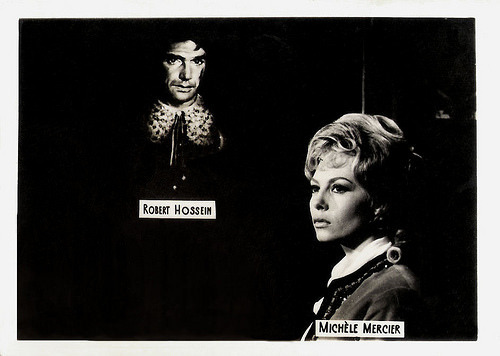
Robert Hossein and Michèle Mercier . Romanian mini-card.
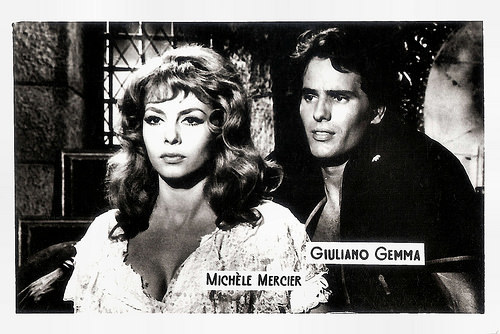
Romanian mini-card. Photo: publicity still for Angélique, marquise des anges/Angélique (Bernard Borderie, 1964) with Michèle Mercier and Giuliano Gemma .
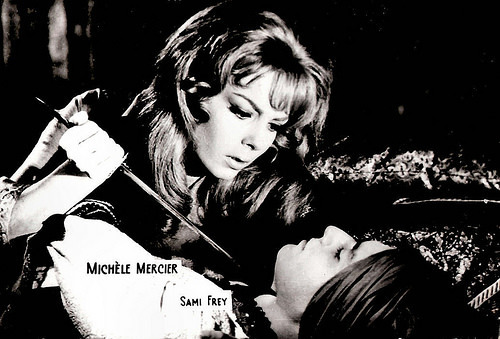
Small Romanian collectors card. Photo: publicity still for Angélique et le roy/Angelique and the King (Bernard Borderie, 1966) with Michèle Mercier and Samy Frey .
Unique flair for historical costume dramas
Some of the Angélique novels were adapted into a series of five popular films:
Angélique, Marquise des Anges/Angélique (1964).Merveilleuse Angelique/Angelique: The Road to Versailles (1965).Angélique et le roy/Angelique and the King (1966).Indomptable Angelique/Untamable Angelique (1967).Angélique et le sultan/Angelique and the Sultan (1968).
According to James Travers at Films de France, Angélique, Marquise des Anges/Angélique is notably the best of the series: "the adventures of a beautiful 17th century marquise, Angélique, played magnificently by Michèle Mercier . Although rarely seen outside of continental Europe, these films were very successful in France in the 1960s and display that country's unique flair for historical costume dramas."
The films were a joint production of France, Italy and Germany. Director of the whole series of films was Bernard Borderie and the main stars were Michèle Mercier as Angélique Sancé de Monteloup and Robert Hossein as Jeoffrey de Peyrac.
Other characters were played by Jean Rochefort as Desgrez, Giuliano Gemma as Angelique's childhood friend Nicolas Merlot, Jacques Toja as King Louis XIV, Claude Giraud as Angélique's second husband Philippe de Plessis-Bellières, Jean-Louis Trintignant as the poet Claude le Petit, Samy Frey as Bachtiary Bey, Estella Blain as the evil Madame De Montespan, Fred Williams as Ràkóczi, and in the final film Jean-Claude Pascal as Sultan Osman Ferradji.
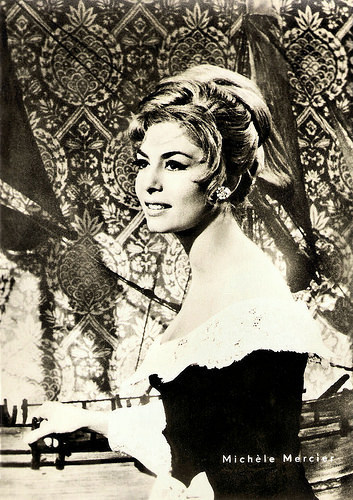
Michèle Mercier . East-German postcard by VEB Progress Film-Vertrieb, Berlin, no. 35/71, 1971. Retail price: 0,20 DM. Photo: Progress.

Romanian postcard by Casa Filmului Acin. Photo: publicity still for Indomptable Angelique/Untamable Angelique (Bernard Borderie, 1967) with Robert Hossein and Michèle Mercier .
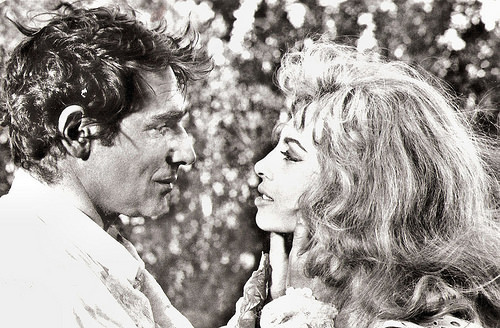
Romanian postcard by Casa Filmului Acin. Photo: publicity still for Indomptable Angelique/Untamable Angélique (Bernard Borderie, 1967) with Robert Hossein and Michèle Mercier .
A Turkish Angélique
The Angélique films were popular all over Europe. They were also very popular in Central Europe where the postcards used for this post were published, by Progress in East-Germany and by Acin in Romania.
During the 1970s, all the kids at my school were exited to see the Angélique films when they were shown on Dutch television. Romance, adventure, and a tiny bit of nudity. We loved it.
To my surprise, two Turkish Angélique films exist as well: Anjelik Osmanli saraylarinda/Angélique in the Ottoman Palaces (Ülkü Erakalin, 1967) and Anjelik ve Deli Ibrahim/Angelique and Deli Ibrahim (Süha Dogan, 1968), both starring Sevda Ferdag as Anjelik 'Angélique de Peyrac'. The first film gets a 7,9 rating at IMDb .
In 2013, a remake of Angélique, marquise des anges went in premiere: Angélique (Ariel Zeitoun, 2013). Nora Arnezeder played Angelique and Gérard Lanvin Joffrey de Peyrac.
At IMDb , the film received a poor rating of only 5,6, but Polish reviewer Malgga liked it 'very, very much': "A beautiful, engaging and immensely romantic rendition of the 'Beauty and the Beast' fairy tale motive".
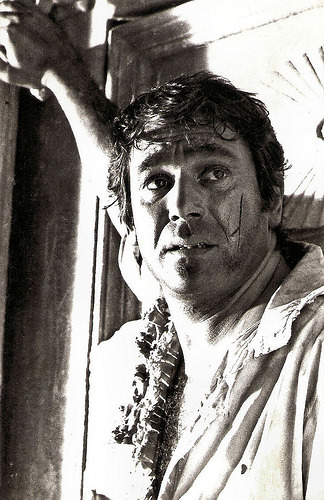
Romanian postcard by Casa Filmului Acin, no. 277. Photo: publicity still for Angelique et le sultan/Angelique and the Sultan (Bernard Borderie, 1968) with Robert Hossein .
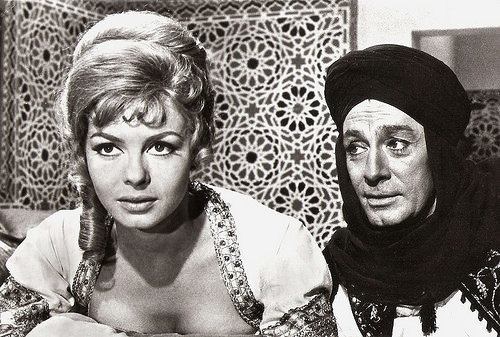
Romanian postcard by Casa Filmului Acin. Photo: publicity still for Angelique et le sultan/Angelique and the sultan (Bernard Borderie, 1968) with Michèle Mercier and Jean-Claude Pascal .

French photo by Francos Film - C.I.C.C. (Paris), Gloria Film (Munich), Fono Roma (Rome). Publicity still for Indomptable Angélique/Untamable Angelique (Bernard Borderie, 1967).
Reduced to a state close to poverty
In 1972, Anne and Serge Golon went to Canada to continue their research. That year, as Anne wrote Angélique and the Ghosts, but Serge died. They had four children: Cyrille (born February 1950), Nadine (born July 1955), Pierre (born April 1957), and Marina (born 1961).
Anne carried on writing and brought up her four children at the same time. Between Serge's death and 1985, Anne wrote four more volumes, beginning with the second half of Ghosts (both portions published in French as a single volume, Angélique à Quebec (Angelique in Quebec)) and proceeding through Victoire d'Angélique (Angélique's Victory).
Anne Golon was reduced to a state close to poverty and filed a lawsuit against the French publisher Hachette for abuse of copyright and for her unpaid royalties. She won her battle over the publishing rights to her Angélique stories.
After a legal battle in France lasting nearly a decade, she reached an agreement which left her the sole owner of the works. In 2009, Golon announced two more books would follow: Royaume de France, (Kingdom of France), and a fifteenth and final volume to complete the series.
On 14 July 2017 Anne Golon died in Versailles, Yvelines, France. She was 95. Estimates of the total number of Angélique books sold worldwide are upwards of 150 million, and they have been published in at least 63 countries, by at least 320 different publishers.
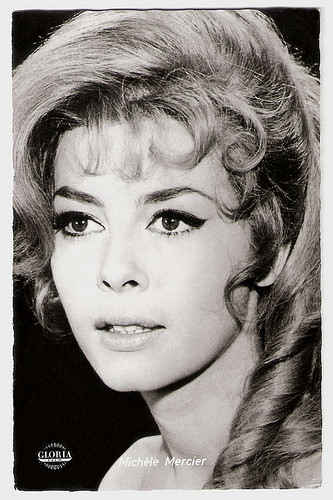
West-German postcard by Friedrich-W. Sander-Verlag / Kolibri-Verlag, Minden-Westf., no. 2420. Photo: Gloria-Film. Publicity still for Angélique, marquise des anges/Angélique (Bernard Borderie, 1964).
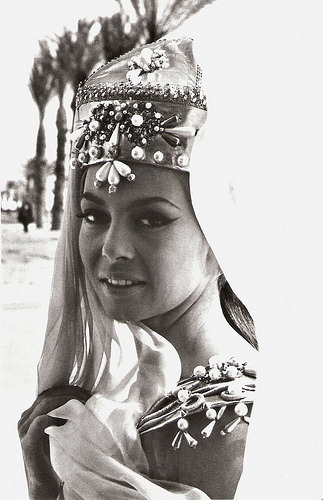
Romanian postcard by Casa Filmului Acin. Photo: publicity still for Angelique et le sultan/Angelique and the sultan (Bernard Borderie, 1968) with Michèle Mercier .
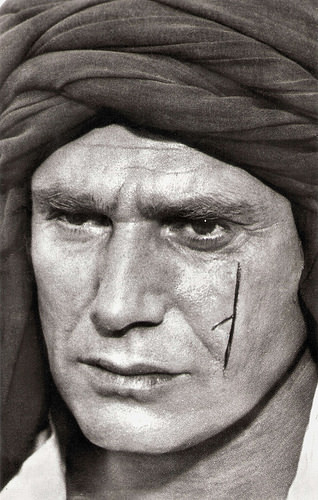
Romanian postcard by Casa Filmului Acin. Photo: publicity still for Angelique et le sultan/Angelique and the Sultan (Bernard Borderie, 1968) with Robert Hossein .
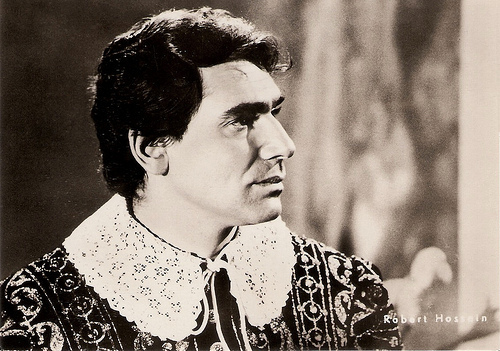
Robert Hossein . East-German postcard by VEB Progress Film-Vertrieb, Berlin, no. 32/71. Retail price: 0,20 M.
Sources: James Travers (Films de France), Wikipedia and .

Vintage card. Photo: publicity still for Angélique, marquise des anges/Angélique (Bernard Borderie, 1964) with Michèle Mercier .

Michèle Mercier . East-German postcard by VEB Progress Film-Vertrieb, Berlin, no. 25/71, 1971. Retail price: 0,20 DM. Photo: Progress.

West-German postcard by ISV, no. H-137. Photo: publicity still for Angelique et le roy/Angélique and the King (Bernard Borderie, 1965).
An Overnight Success
Anne and Serge Golon published a series of 13 French historical adventure books on Angélique. In fact, Anne Golon is the author and her husband Serge did much of the historical research. International publishers published their books with as the authors name Sergeanne Golon
Anne was born Simone Changeux in Toulon, a port in south-eastern France, in 1921. She was the daughter of Pierre Changeux, a scientist and a captain in the French Navy. She was interested in painting and writing from early childhood and published her first novel, The Country from behind my Eyes, when she was 18 under the pen name Joëlle Danterne.
During World War II Anne travelled via bicycle through France to Spain. She wrote using different pen-names, helped to create France Magazine, and was awarded a literary prize for The Patrol of the Saint Innocents.[4]
She was sent to Africa as a journalist, where she met Vsevolod Sergeïvich Goloubinoff, her future husband, Serge Golon. Their first novel, Angélique, the Marquise of the Angels, was published in 1957. The book was an overnight success. Heroine Angélique de Sancé de Monteloup is a lusciously beautiful 17th Century woman, fifth child of an impoverished country nobleman in the Poitou marshlands in the west of France.
Wikipedia gives a bit ironic summary of the successive books: "she marries at a young age the romantic and talented Count of Toulouse; gets her domestic bliss destroyed when King Louis XIV has her husband executed on trumped up charges; descends into the underworld of Paris; emerges and through a turbulent second marriage gets admittance to the court in Versailles; loses her second husband in war, just as she had started to truly love him, and subsequently refuses to become the King's mistress; finds that her first husband is after all alive and is hiding somewhere in the Mediterranean; sets out on a highly risky search, gets captured by pirates, sold into slavery in Crete, taken into the harem of the King of Morocco, stabs the King when he tries to have sex with her, and stages a daring escape" etc.

Robert Hossein and Michèle Mercier . Romanian mini-card.

Romanian mini-card. Photo: publicity still for Angélique, marquise des anges/Angélique (Bernard Borderie, 1964) with Michèle Mercier and Giuliano Gemma .

Small Romanian collectors card. Photo: publicity still for Angélique et le roy/Angelique and the King (Bernard Borderie, 1966) with Michèle Mercier and Samy Frey .
Unique flair for historical costume dramas
Some of the Angélique novels were adapted into a series of five popular films:
Angélique, Marquise des Anges/Angélique (1964).Merveilleuse Angelique/Angelique: The Road to Versailles (1965).Angélique et le roy/Angelique and the King (1966).Indomptable Angelique/Untamable Angelique (1967).Angélique et le sultan/Angelique and the Sultan (1968).
According to James Travers at Films de France, Angélique, Marquise des Anges/Angélique is notably the best of the series: "the adventures of a beautiful 17th century marquise, Angélique, played magnificently by Michèle Mercier . Although rarely seen outside of continental Europe, these films were very successful in France in the 1960s and display that country's unique flair for historical costume dramas."
The films were a joint production of France, Italy and Germany. Director of the whole series of films was Bernard Borderie and the main stars were Michèle Mercier as Angélique Sancé de Monteloup and Robert Hossein as Jeoffrey de Peyrac.
Other characters were played by Jean Rochefort as Desgrez, Giuliano Gemma as Angelique's childhood friend Nicolas Merlot, Jacques Toja as King Louis XIV, Claude Giraud as Angélique's second husband Philippe de Plessis-Bellières, Jean-Louis Trintignant as the poet Claude le Petit, Samy Frey as Bachtiary Bey, Estella Blain as the evil Madame De Montespan, Fred Williams as Ràkóczi, and in the final film Jean-Claude Pascal as Sultan Osman Ferradji.

Michèle Mercier . East-German postcard by VEB Progress Film-Vertrieb, Berlin, no. 35/71, 1971. Retail price: 0,20 DM. Photo: Progress.

Romanian postcard by Casa Filmului Acin. Photo: publicity still for Indomptable Angelique/Untamable Angelique (Bernard Borderie, 1967) with Robert Hossein and Michèle Mercier .

Romanian postcard by Casa Filmului Acin. Photo: publicity still for Indomptable Angelique/Untamable Angélique (Bernard Borderie, 1967) with Robert Hossein and Michèle Mercier .
A Turkish Angélique
The Angélique films were popular all over Europe. They were also very popular in Central Europe where the postcards used for this post were published, by Progress in East-Germany and by Acin in Romania.
During the 1970s, all the kids at my school were exited to see the Angélique films when they were shown on Dutch television. Romance, adventure, and a tiny bit of nudity. We loved it.
To my surprise, two Turkish Angélique films exist as well: Anjelik Osmanli saraylarinda/Angélique in the Ottoman Palaces (Ülkü Erakalin, 1967) and Anjelik ve Deli Ibrahim/Angelique and Deli Ibrahim (Süha Dogan, 1968), both starring Sevda Ferdag as Anjelik 'Angélique de Peyrac'. The first film gets a 7,9 rating at IMDb .
In 2013, a remake of Angélique, marquise des anges went in premiere: Angélique (Ariel Zeitoun, 2013). Nora Arnezeder played Angelique and Gérard Lanvin Joffrey de Peyrac.
At IMDb , the film received a poor rating of only 5,6, but Polish reviewer Malgga liked it 'very, very much': "A beautiful, engaging and immensely romantic rendition of the 'Beauty and the Beast' fairy tale motive".

Romanian postcard by Casa Filmului Acin, no. 277. Photo: publicity still for Angelique et le sultan/Angelique and the Sultan (Bernard Borderie, 1968) with Robert Hossein .

Romanian postcard by Casa Filmului Acin. Photo: publicity still for Angelique et le sultan/Angelique and the sultan (Bernard Borderie, 1968) with Michèle Mercier and Jean-Claude Pascal .

French photo by Francos Film - C.I.C.C. (Paris), Gloria Film (Munich), Fono Roma (Rome). Publicity still for Indomptable Angélique/Untamable Angelique (Bernard Borderie, 1967).
Reduced to a state close to poverty
In 1972, Anne and Serge Golon went to Canada to continue their research. That year, as Anne wrote Angélique and the Ghosts, but Serge died. They had four children: Cyrille (born February 1950), Nadine (born July 1955), Pierre (born April 1957), and Marina (born 1961).
Anne carried on writing and brought up her four children at the same time. Between Serge's death and 1985, Anne wrote four more volumes, beginning with the second half of Ghosts (both portions published in French as a single volume, Angélique à Quebec (Angelique in Quebec)) and proceeding through Victoire d'Angélique (Angélique's Victory).
Anne Golon was reduced to a state close to poverty and filed a lawsuit against the French publisher Hachette for abuse of copyright and for her unpaid royalties. She won her battle over the publishing rights to her Angélique stories.
After a legal battle in France lasting nearly a decade, she reached an agreement which left her the sole owner of the works. In 2009, Golon announced two more books would follow: Royaume de France, (Kingdom of France), and a fifteenth and final volume to complete the series.
On 14 July 2017 Anne Golon died in Versailles, Yvelines, France. She was 95. Estimates of the total number of Angélique books sold worldwide are upwards of 150 million, and they have been published in at least 63 countries, by at least 320 different publishers.

West-German postcard by Friedrich-W. Sander-Verlag / Kolibri-Verlag, Minden-Westf., no. 2420. Photo: Gloria-Film. Publicity still for Angélique, marquise des anges/Angélique (Bernard Borderie, 1964).

Romanian postcard by Casa Filmului Acin. Photo: publicity still for Angelique et le sultan/Angelique and the sultan (Bernard Borderie, 1968) with Michèle Mercier .

Romanian postcard by Casa Filmului Acin. Photo: publicity still for Angelique et le sultan/Angelique and the Sultan (Bernard Borderie, 1968) with Robert Hossein .

Robert Hossein . East-German postcard by VEB Progress Film-Vertrieb, Berlin, no. 32/71. Retail price: 0,20 M.
Sources: James Travers (Films de France), Wikipedia and .
Published on July 17, 2017 22:00
July 16, 2017
Maria Orska
Maria Orska (1893-1930) was a Russian-Jewish actress of the German stage and screen in the 1910s and 1920s. She was a darling of the public, but became the talk of Berlin when she became a morphine addict and did several suicide attempts.
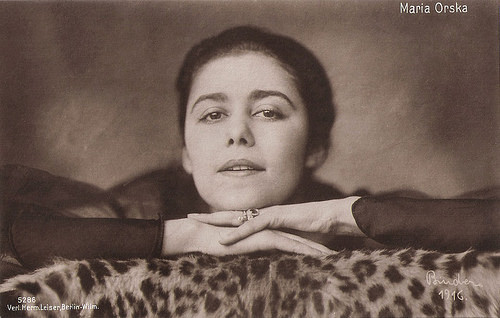
German postcard by Verlag Hermann Leiser, Berlin-Wilm., no. 5286. Photo: Alex Binder, 1916.
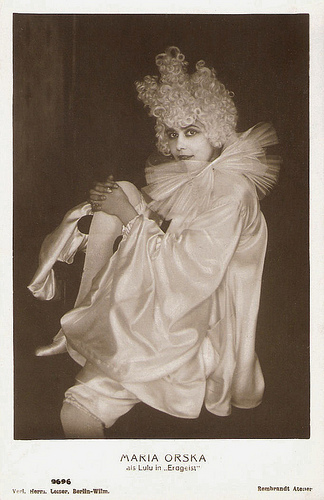
German postcard by Verlag Hermann Leiser, Berlin-Wilm., no. 9696. Photo: Rembrandt Atelier. Maria Orska in her role as Lulu in the stage play Erdgeist (Earth Spirit) by Franz Wedekind, directed in 1916 by Max Reinhardt.
The darling of the audience
Maria Orska was born Effi Rahel Blindermann in Nikolayev, Russian Empire (now Mikolaiv in Ukraine), in 1893. She was the cousin of the German actress Hedda Forsten and by her mother parented to the theatre impresario Eugen Frankfurter.
Although she originally wanted to study law like her father wanted her to, she became a stage actress and was discovered by the German actor and drama teacher Ferdinand Gregori when in St. Petersburg. In 1909 he brought her to Vienna's conservatory Akademie für Musik und darstellende Kunst (today Universität für Musik und darstellende Kunst Wien), led by him.
In 1910, she followed Gregori to the Mannheim court theater where she debuted as Daisy Orska and soon drew attention to herself in plays by August Strindberg and Arthur Schnitzler.
In 1911 she came to the Schauspielhaus in Hamburg, where she became the star of the company. In the season 1914/1915 Maria Orska, her stage name by now, moved to Berlin, where she performed at the Theater in der Königgrätzer Straße (today Hebbel-Theater) as well as Max Reinhardt’s Berlin stage. In the same year Edith Andreae was introduced to her, with whom she held a long lasting friendship.
In Berlin the exiled Russian artist became known as interpreter of the works by modern playwrights such as Oscar Wilde, Strindberg, Schnitzler, Frank Wedekind and Luigi Pirandello. She was a huge success in Wedekind’s Lulu in 1916.
The star was praised as "the unmatched interpreter of Strindberg's women, the most fashionable actress of today's Berlin". She was the representative of an "art entirely dedicated to nerves" ( Der Film , no. 23, 01.07.1916).
"She had sharp, piercing tones, the uncanny effect of which the little character fanatically exaggerated. She also cultivated mundane roles, in which she unfolded the pointed humours of a devious character ... In the field of erotic representation she dared to go remarkably far. She was not an elementary artist, but she had individual qualities that made her the darling of the audience“, the reporter and author Emil Faktor noted in the Berliner Börsen-Courier (16.05.1930) after her tragic death.
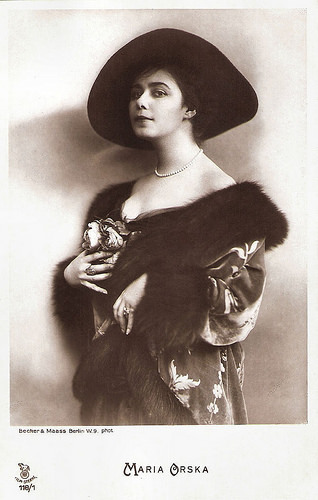
German postcard in the Film Sterne series by Rotophot, no. 118/1. Photo: Becker & Maass, Berlin.
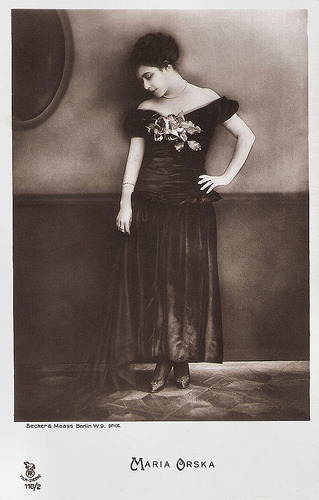
German postcard in the Film Sterne series by Rotophot , no. 118/2. Photo: Becker & Maass, Berlin.
The centre of the so-called Berlin society
The ambitious Maria Orska maintained an elaborate lifestyle since her marriage in 1920 to her second husband, Baron Dr. Hans von Bleichröder jun., a grandson of the Jewish banker Gerson von Bleichröder. For a long time, Baroness von Bleichröder was at the centre of the so-called Berlin society, and also knew how to stage herself in private as an eccentric spectacle.
Her popularity was reinforced by the cinema. In 1915 she had begun a second career as a silent film star and soon she received top salaries. Maria Orska gave her screen debut at the Greenbaum-Film GmbH in Richard Oswald's melodrama Dämon und Mensch/Demon and Man (1915) and played the shady Lina, who wants to take a cleansed criminal (Rudolf Schildkraut) away from the path of virtue.
Her photographs appeared on covers of countless magazines, and postcards with her portraits were distributed all over Europe.
Maria Orska worked for the first time with the filmmaker and director Max Mack at Das tanzende Herz/The Dancing Heart (Max Mack, 1916), which effected in a six-part Maria Orska film series for the cinemas in 1916/1917, with Orska herself as protagonist in each film.
As a girl from the gutter she presented herself in Der Sumpf/The Gutter (Max Mack, 1916), but also in comedies such as Die Sektwette/The Champagne Bet (Max Mack, 1916) she was able to win the audience for herself.
Especially in melodramas, Orska performed the type of the wicked woman such as in Adamant's Letztes Rennen/Adamant’s Last Race (Max Mack, 1917) starring Trude Berliner , and Der lebende Tote/The Living Dead (Max Mack, 1917).
Mack also directed her in Die schwarze Loo/Black Lu (Max Mack, Louis Neher, 1917) as a gypsy woman who becomes the talk of the town, and who almost wrecks the marriage of a musician ( Bruno Kastner ). Between push dancing and amorous intrigue, the film develops its highly dared action for those days in expressive images and pointed situations, in which with remarkable determination the stern morality of the late German Imperial Empire is shaken.
Die schwarze Loo was the last part of the Maria Orska-series, which Mack realised for Greenbaum-Film. Then Maria Orska took a break from the film business and for the next three years she focused on her stage work.
In 1920 she returned to the screen in the film Die letzte Stunde/The Last Hour, directed by Dimitri Buchowetzki, and the Emile Zola adaptation Die Bestie im Menschen/The Human Beast (Ludwig Wolff, 1921) with Russian actor Ossip Runitsch , Der Streik der Diebe/The Thieves’ Strike (Alfred Abel, 1921), and Paul Czinner's drama Opfer der Leidenschaft/Victims of Passion (1922) as female partner of Paul Bildt.
Maria Orska finished her film career with the role of the capricious dancer Barberina Campanini in the first and third part of the Fridericus Rex series, Sturm und Drang (Arzén von Cserépy, 1922) and Sanssouci (Arzén von Cserépy, 1923) opposite Otto Gebühr as Friedrich II.
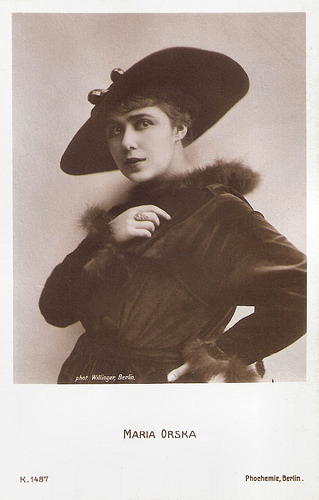
German postcard by Photochemie, no. K 1487. Photo: Willinger, Berlin.
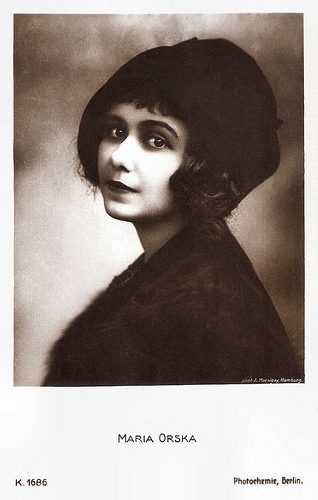
German postcard by Photochemie, Berlin, no. K. 1685. Photo: A. Moesigay, Hamburg.
The talk of the town
Maria Orska’s attempt to become a stage actress in Paris failed. Disappointed, the celebrated artist returned to Berlin and accepted commitments at the Komödienhaus, the Deutsches Theater and the Lessing Theater. In 1927 for instance, Orska played the lesbian Ruth in Hans Kaltneker's mystery play The Sisters at the Theater in the Königgrätzer Strasse in Berlin.
More and more however, Orska’s health visibly deteriorated by her morphine addiction. Divorced since 1925 by her husband, Dr. Hans von Bleichröder, Maria Orska became the talk of the town because of her desire for death and her drug consumption. Nurses waited on the side stage with a syringe, directors dreaded every performance. Her suicide attempts - once she jumped off a train - soon became routine for the public. "They saw her already as a typical character, they were each time after a rest and detox pause in the sanatorium, which the demon hunted artist used to leave like a fury, in order to escape from a life that had become worthless for her", Emil Faktor wrote in 1930.
All rehab attempts by Orska proved failures. She finally poisoned herself by an overdose of Veronal. The actress was brought to the Viennese General Hospital, where she died on 16 May 1930, at the age of only 37 – she couldn’t cope with a pneumonia because of her weakened body.
Two years earlier Maria Orska's lover, the wealthy Jewish industrialist and geologist Julius Heinrich Koritschoner from Vienna, had shot himself in Constantinople in 1928. Before his death he had written a letter to Orska. His morphine addiction is thought to have made him suicidal.
The life of Orska's sister Gabryela had also ended tragically. Gabryela, born in 1894, had become Marchesa di Serra Mantschedda when she married an Italian aristocrat. In 1924 (or 1926), Gabryela hanged herself in a Viennese hotel. Wikipedia claims it was after a row with her sister Maria.
Their brother Edwin, an aviator in the Russian Imperial Army, survived the First World War, the Bolshevik revolution, the Nazis, and his sisters. In 1938 he emigrated from Germany to Ecuador where he married in 1938 and died in Quito in 1966.
The famous artist Oskar Kokoschka drew the actress in 1922. Lithographies after his work hang in various museums, e.g. the Staatlichen Kunstsammlungen Dresden.
Finally, Fritz Engel wrote: "Maria Orska was completely subordinate to the intoxication of the stage until it crushed her. Her strange appearance confirmed how difficult it is to understand the phenomenon of the stage actor. She seemed so enveloped in the air of the scene, but at the same time she remained so simple. She was a theatrical crowd-puller and a rhetorical star, such as Wilde’s Salome, and was also the most humble of Hedwig in Wildente (The Wild Duck) by Ibsen. She was hot and cold, she played and she lived".
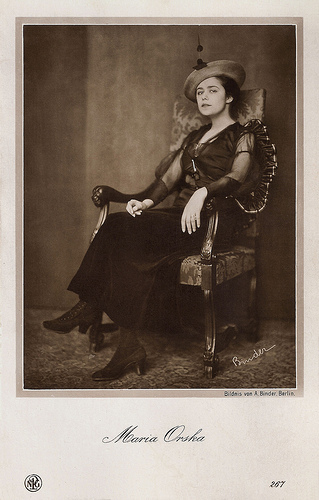
German postcard by NPG (Neue Photographische Gesellschaft), no. 267. Photo: Alex Binder, Berlin.
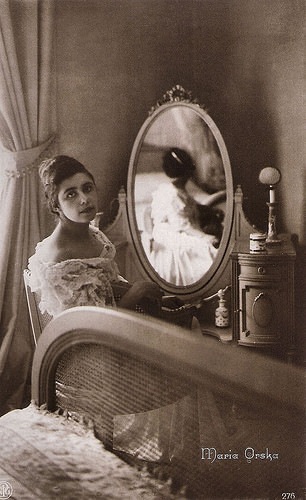
German postcard by NPG, no. 276.
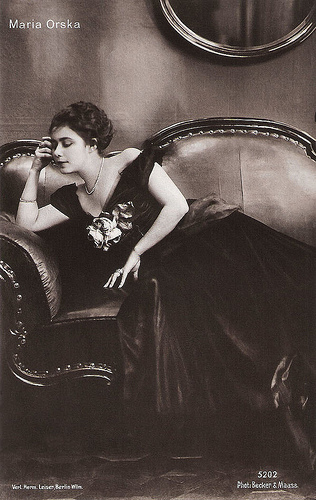
German postcard by Verlag Hermann Leiser, Berlin-Wilm., no. 5201. Photo: Becker & Maass.
Sources: Stephanie D'heil (Steffi_line - German), Filmportal.de, Wikipedia (German) and .

German postcard by Verlag Hermann Leiser, Berlin-Wilm., no. 5286. Photo: Alex Binder, 1916.

German postcard by Verlag Hermann Leiser, Berlin-Wilm., no. 9696. Photo: Rembrandt Atelier. Maria Orska in her role as Lulu in the stage play Erdgeist (Earth Spirit) by Franz Wedekind, directed in 1916 by Max Reinhardt.
The darling of the audience
Maria Orska was born Effi Rahel Blindermann in Nikolayev, Russian Empire (now Mikolaiv in Ukraine), in 1893. She was the cousin of the German actress Hedda Forsten and by her mother parented to the theatre impresario Eugen Frankfurter.
Although she originally wanted to study law like her father wanted her to, she became a stage actress and was discovered by the German actor and drama teacher Ferdinand Gregori when in St. Petersburg. In 1909 he brought her to Vienna's conservatory Akademie für Musik und darstellende Kunst (today Universität für Musik und darstellende Kunst Wien), led by him.
In 1910, she followed Gregori to the Mannheim court theater where she debuted as Daisy Orska and soon drew attention to herself in plays by August Strindberg and Arthur Schnitzler.
In 1911 she came to the Schauspielhaus in Hamburg, where she became the star of the company. In the season 1914/1915 Maria Orska, her stage name by now, moved to Berlin, where she performed at the Theater in der Königgrätzer Straße (today Hebbel-Theater) as well as Max Reinhardt’s Berlin stage. In the same year Edith Andreae was introduced to her, with whom she held a long lasting friendship.
In Berlin the exiled Russian artist became known as interpreter of the works by modern playwrights such as Oscar Wilde, Strindberg, Schnitzler, Frank Wedekind and Luigi Pirandello. She was a huge success in Wedekind’s Lulu in 1916.
The star was praised as "the unmatched interpreter of Strindberg's women, the most fashionable actress of today's Berlin". She was the representative of an "art entirely dedicated to nerves" ( Der Film , no. 23, 01.07.1916).
"She had sharp, piercing tones, the uncanny effect of which the little character fanatically exaggerated. She also cultivated mundane roles, in which she unfolded the pointed humours of a devious character ... In the field of erotic representation she dared to go remarkably far. She was not an elementary artist, but she had individual qualities that made her the darling of the audience“, the reporter and author Emil Faktor noted in the Berliner Börsen-Courier (16.05.1930) after her tragic death.

German postcard in the Film Sterne series by Rotophot, no. 118/1. Photo: Becker & Maass, Berlin.

German postcard in the Film Sterne series by Rotophot , no. 118/2. Photo: Becker & Maass, Berlin.
The centre of the so-called Berlin society
The ambitious Maria Orska maintained an elaborate lifestyle since her marriage in 1920 to her second husband, Baron Dr. Hans von Bleichröder jun., a grandson of the Jewish banker Gerson von Bleichröder. For a long time, Baroness von Bleichröder was at the centre of the so-called Berlin society, and also knew how to stage herself in private as an eccentric spectacle.
Her popularity was reinforced by the cinema. In 1915 she had begun a second career as a silent film star and soon she received top salaries. Maria Orska gave her screen debut at the Greenbaum-Film GmbH in Richard Oswald's melodrama Dämon und Mensch/Demon and Man (1915) and played the shady Lina, who wants to take a cleansed criminal (Rudolf Schildkraut) away from the path of virtue.
Her photographs appeared on covers of countless magazines, and postcards with her portraits were distributed all over Europe.
Maria Orska worked for the first time with the filmmaker and director Max Mack at Das tanzende Herz/The Dancing Heart (Max Mack, 1916), which effected in a six-part Maria Orska film series for the cinemas in 1916/1917, with Orska herself as protagonist in each film.
As a girl from the gutter she presented herself in Der Sumpf/The Gutter (Max Mack, 1916), but also in comedies such as Die Sektwette/The Champagne Bet (Max Mack, 1916) she was able to win the audience for herself.
Especially in melodramas, Orska performed the type of the wicked woman such as in Adamant's Letztes Rennen/Adamant’s Last Race (Max Mack, 1917) starring Trude Berliner , and Der lebende Tote/The Living Dead (Max Mack, 1917).
Mack also directed her in Die schwarze Loo/Black Lu (Max Mack, Louis Neher, 1917) as a gypsy woman who becomes the talk of the town, and who almost wrecks the marriage of a musician ( Bruno Kastner ). Between push dancing and amorous intrigue, the film develops its highly dared action for those days in expressive images and pointed situations, in which with remarkable determination the stern morality of the late German Imperial Empire is shaken.
Die schwarze Loo was the last part of the Maria Orska-series, which Mack realised for Greenbaum-Film. Then Maria Orska took a break from the film business and for the next three years she focused on her stage work.
In 1920 she returned to the screen in the film Die letzte Stunde/The Last Hour, directed by Dimitri Buchowetzki, and the Emile Zola adaptation Die Bestie im Menschen/The Human Beast (Ludwig Wolff, 1921) with Russian actor Ossip Runitsch , Der Streik der Diebe/The Thieves’ Strike (Alfred Abel, 1921), and Paul Czinner's drama Opfer der Leidenschaft/Victims of Passion (1922) as female partner of Paul Bildt.
Maria Orska finished her film career with the role of the capricious dancer Barberina Campanini in the first and third part of the Fridericus Rex series, Sturm und Drang (Arzén von Cserépy, 1922) and Sanssouci (Arzén von Cserépy, 1923) opposite Otto Gebühr as Friedrich II.

German postcard by Photochemie, no. K 1487. Photo: Willinger, Berlin.

German postcard by Photochemie, Berlin, no. K. 1685. Photo: A. Moesigay, Hamburg.
The talk of the town
Maria Orska’s attempt to become a stage actress in Paris failed. Disappointed, the celebrated artist returned to Berlin and accepted commitments at the Komödienhaus, the Deutsches Theater and the Lessing Theater. In 1927 for instance, Orska played the lesbian Ruth in Hans Kaltneker's mystery play The Sisters at the Theater in the Königgrätzer Strasse in Berlin.
More and more however, Orska’s health visibly deteriorated by her morphine addiction. Divorced since 1925 by her husband, Dr. Hans von Bleichröder, Maria Orska became the talk of the town because of her desire for death and her drug consumption. Nurses waited on the side stage with a syringe, directors dreaded every performance. Her suicide attempts - once she jumped off a train - soon became routine for the public. "They saw her already as a typical character, they were each time after a rest and detox pause in the sanatorium, which the demon hunted artist used to leave like a fury, in order to escape from a life that had become worthless for her", Emil Faktor wrote in 1930.
All rehab attempts by Orska proved failures. She finally poisoned herself by an overdose of Veronal. The actress was brought to the Viennese General Hospital, where she died on 16 May 1930, at the age of only 37 – she couldn’t cope with a pneumonia because of her weakened body.
Two years earlier Maria Orska's lover, the wealthy Jewish industrialist and geologist Julius Heinrich Koritschoner from Vienna, had shot himself in Constantinople in 1928. Before his death he had written a letter to Orska. His morphine addiction is thought to have made him suicidal.
The life of Orska's sister Gabryela had also ended tragically. Gabryela, born in 1894, had become Marchesa di Serra Mantschedda when she married an Italian aristocrat. In 1924 (or 1926), Gabryela hanged herself in a Viennese hotel. Wikipedia claims it was after a row with her sister Maria.
Their brother Edwin, an aviator in the Russian Imperial Army, survived the First World War, the Bolshevik revolution, the Nazis, and his sisters. In 1938 he emigrated from Germany to Ecuador where he married in 1938 and died in Quito in 1966.
The famous artist Oskar Kokoschka drew the actress in 1922. Lithographies after his work hang in various museums, e.g. the Staatlichen Kunstsammlungen Dresden.
Finally, Fritz Engel wrote: "Maria Orska was completely subordinate to the intoxication of the stage until it crushed her. Her strange appearance confirmed how difficult it is to understand the phenomenon of the stage actor. She seemed so enveloped in the air of the scene, but at the same time she remained so simple. She was a theatrical crowd-puller and a rhetorical star, such as Wilde’s Salome, and was also the most humble of Hedwig in Wildente (The Wild Duck) by Ibsen. She was hot and cold, she played and she lived".

German postcard by NPG (Neue Photographische Gesellschaft), no. 267. Photo: Alex Binder, Berlin.

German postcard by NPG, no. 276.

German postcard by Verlag Hermann Leiser, Berlin-Wilm., no. 5201. Photo: Becker & Maass.
Sources: Stephanie D'heil (Steffi_line - German), Filmportal.de, Wikipedia (German) and .
Published on July 16, 2017 22:00
July 15, 2017
Margaret Rung
Beautiful blond Danish showgirl Margaret Rung (1933) appeared in supporting and small parts in French films of the late 1950s. Her main claim to fame was dating former King Farouk of Egypt, shortly after his separation from Queen Narriman in 1953.
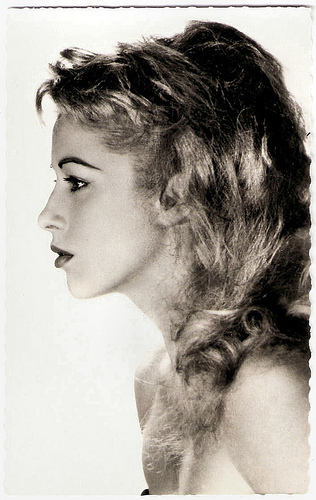
French postcard by Editions P.I., Paris, no. 846, offered by Les Carboplanes Korés Carboplane. Photo: Sam Lévin. The postcard is probably made for her French film debut in 1956, because at the flipside she is credited as Margareth Rung.
Tight Black Sweater
On 17 March 1953, Danish dancer Margarethe Rung Jorgenson revealed to the press in Rome, that she was the ‘mysterious blonde’ who had been dating former King Farouk of Egypt since his separation from ex-Queen Narriman. This gossip news caused international headlines and photos of the beautiful blonde were sent by radio or wire all over the world.
A subscript of a United Press Telephoto described her as a ’22-year-old chorus girl’. American newspaper The Amsterdam Evening Recorder used a wirephoto by AP and described her as a ‘19-year-old dancer’ from Copenhagen. For the photographers she had posed in a tight black sweater. She had told newsmen that she had met Farouk at 12 March, the same night Narriman had taken off for Switzerland.
Since then Farouk and Margarethe had been out ‘two or three times’. At the time Rung lived in a room in a small hotel in Rome, which she shared with her sister. This breaking news probably finished the affair but it lead to a break in films for Rung.
Margarethe Rung Jorgenson was born in Copenhagen, Denmark in 1933. She wat the daughter of leather goods manufacturer O. Jørgensen. Margarethe appeared in several Copenhagen revues and played an uncredited bit part as a harem girl in the witty and charming musical comedy Mød mig paa Cassiopeia/Meet Me on Cassiopeia (Torben Anton Svendsen, 1951).
Mød mig paa Cassiopeia is about a Danish Air Force pilot who is working on a musical play and faces writer's block. Polyhymnia (Bodil Kjer), a dazzling muse straight out of Greek mythology, comes to spur him on and inspire him to complete the work. But she falls in love with him. René Michael Knudsen at IMDb : "She is soon haunted by her father Zeus, who wants her back and cannot allow the daughter of a god to mingle too closely with humans. This storyline is filled out with funny side-characters and musical-shows that are clearly not American, but inhere lies the films charm. The acting is very good in all roles. The plot line from the film Xanadu, seems nearly to be a ripoff (or can you call it a remake?)"
In the autumn of 1952, Margrethe Rung travelled to Rome on the recommendation of the dance couple Danoesti to apply for admission to the American Bluebell dance company. This ensemble included 12 girls of different nationalities and it had an international reputation. In the Italian capital they performed In the distinguished revue of Wanda Osiris. The Bluebell girls also performed at Ib Schønberg's circus revue in Bakken, Denmark in the summer of 1953. In the same year, Rung participated in a Nivea commercial colour film, which was featured in the Danish cinemas.
After the Farouk news, she worked in France and South America. Together with her sister Kirsten Rung, she performed at the Lido in Paris. She was also cast in the drama Si tous les gars du monde/If All the Guys in the World... (Christian-Jacque, 1956) with Jean Gaven. It must have been her first film after Mød mig paa Cassiopeia. Credited as Margareth Rung, she played a Polish air hostess who cooperates with a German, an American, the Russian Air Force, and a Danish plane to get medicine to a fisher boat on the North Sea of which the whole crew is ill by food poisoning.
The film title refers to a poem by Paul Fort that says that if all the men and women in the world would hold hands, happiness would be for tomorrow. Pierre Radulescu at IMDb : "The whole story seems at first to be far too pathetic to be taken seriously, but you should see the movie. It communicates you a sense of generosity and solidarity that is irresistible. "
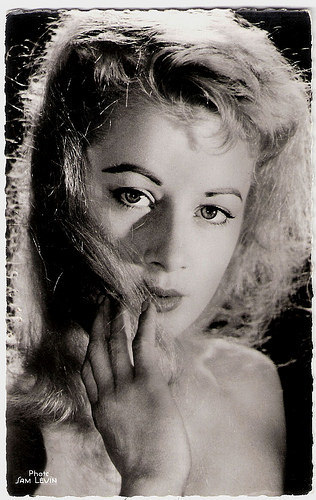
French postcard by Editions du Globe, Paris, no. 642. Photo: Sam Lévin.
No New BB
In 1957, Margaret Rung appeared in four more films. She played a supporting part as one of the beautiful girls around special agent Henri Vidal in Action immediate/To Catch a Spy (Maurice Labro, 1957) based on a thriller by Frédéric Dard.
Next she was seen as an English woman in the French-Italian coproduction Les aventures d'Arsène Lupin/The Adventures of Arsène Lupin (Jacques Becker, 1957) with Robert Lamoureux as the famous French literary icon, gentleman-thief Arsène Lupin.
In Roger Vadim’s Sait-on jamais.../No Sun in Venice (Roger Vadim, 1957), she played a small part as a Venetian countess. Star of the film is Françoise Arnoul as an amoral French girl, who lives in a sumptuous Venetian palazzo as the kept woman of a very rich but undesirable ex-Nazi. Vadim probably did not see the potential of a new Brigitte Bardot in Rung, and her next film was also her last.
Escapade (Ralph Habib, 1957) was an adventure film based on a novel by Cornell Woolrich. Star of the film was Louis Jourdan , and Rung played a supporting part as a young woman.
After two years and seven films Margaret Rung’s career in the French cinema was over. She stayed in Paris, where she married the wealthy director of the Lido and had four children. She died in Paris only 48 years old. Margarethe Rung was the sister of Eva Rung and the dancer Kirsten Rung.
King Farouk was overthrown in the 1952 military coup d'état and forced to abdicate in favour of his infant son Ahmed Fuad, who succeeded him as Fuad II. Farouk divorced his Queen Narriman in 1954. While living in exile in Italy, Farouk met opera singer Irma Capece Minutolo, who became his companion. Farouk died in the Ile de France restaurant in Rome in 1965, collapsing at his dinner table following a characteristically heavy meal. In 2005, his Irma claimed that she had married the former King in 1957.
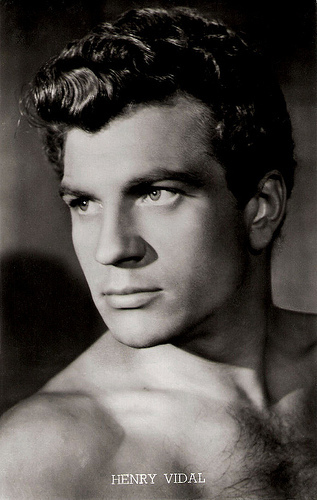
Henri Vidal . French postcard, no. 952.
Sources: Dansk film database (Danish), David Henry (Flickr), The Amsterdam Evening Recorder, Wikipedia and .

French postcard by Editions P.I., Paris, no. 846, offered by Les Carboplanes Korés Carboplane. Photo: Sam Lévin. The postcard is probably made for her French film debut in 1956, because at the flipside she is credited as Margareth Rung.
Tight Black Sweater
On 17 March 1953, Danish dancer Margarethe Rung Jorgenson revealed to the press in Rome, that she was the ‘mysterious blonde’ who had been dating former King Farouk of Egypt since his separation from ex-Queen Narriman. This gossip news caused international headlines and photos of the beautiful blonde were sent by radio or wire all over the world.
A subscript of a United Press Telephoto described her as a ’22-year-old chorus girl’. American newspaper The Amsterdam Evening Recorder used a wirephoto by AP and described her as a ‘19-year-old dancer’ from Copenhagen. For the photographers she had posed in a tight black sweater. She had told newsmen that she had met Farouk at 12 March, the same night Narriman had taken off for Switzerland.
Since then Farouk and Margarethe had been out ‘two or three times’. At the time Rung lived in a room in a small hotel in Rome, which she shared with her sister. This breaking news probably finished the affair but it lead to a break in films for Rung.
Margarethe Rung Jorgenson was born in Copenhagen, Denmark in 1933. She wat the daughter of leather goods manufacturer O. Jørgensen. Margarethe appeared in several Copenhagen revues and played an uncredited bit part as a harem girl in the witty and charming musical comedy Mød mig paa Cassiopeia/Meet Me on Cassiopeia (Torben Anton Svendsen, 1951).
Mød mig paa Cassiopeia is about a Danish Air Force pilot who is working on a musical play and faces writer's block. Polyhymnia (Bodil Kjer), a dazzling muse straight out of Greek mythology, comes to spur him on and inspire him to complete the work. But she falls in love with him. René Michael Knudsen at IMDb : "She is soon haunted by her father Zeus, who wants her back and cannot allow the daughter of a god to mingle too closely with humans. This storyline is filled out with funny side-characters and musical-shows that are clearly not American, but inhere lies the films charm. The acting is very good in all roles. The plot line from the film Xanadu, seems nearly to be a ripoff (or can you call it a remake?)"
In the autumn of 1952, Margrethe Rung travelled to Rome on the recommendation of the dance couple Danoesti to apply for admission to the American Bluebell dance company. This ensemble included 12 girls of different nationalities and it had an international reputation. In the Italian capital they performed In the distinguished revue of Wanda Osiris. The Bluebell girls also performed at Ib Schønberg's circus revue in Bakken, Denmark in the summer of 1953. In the same year, Rung participated in a Nivea commercial colour film, which was featured in the Danish cinemas.
After the Farouk news, she worked in France and South America. Together with her sister Kirsten Rung, she performed at the Lido in Paris. She was also cast in the drama Si tous les gars du monde/If All the Guys in the World... (Christian-Jacque, 1956) with Jean Gaven. It must have been her first film after Mød mig paa Cassiopeia. Credited as Margareth Rung, she played a Polish air hostess who cooperates with a German, an American, the Russian Air Force, and a Danish plane to get medicine to a fisher boat on the North Sea of which the whole crew is ill by food poisoning.
The film title refers to a poem by Paul Fort that says that if all the men and women in the world would hold hands, happiness would be for tomorrow. Pierre Radulescu at IMDb : "The whole story seems at first to be far too pathetic to be taken seriously, but you should see the movie. It communicates you a sense of generosity and solidarity that is irresistible. "

French postcard by Editions du Globe, Paris, no. 642. Photo: Sam Lévin.
No New BB
In 1957, Margaret Rung appeared in four more films. She played a supporting part as one of the beautiful girls around special agent Henri Vidal in Action immediate/To Catch a Spy (Maurice Labro, 1957) based on a thriller by Frédéric Dard.
Next she was seen as an English woman in the French-Italian coproduction Les aventures d'Arsène Lupin/The Adventures of Arsène Lupin (Jacques Becker, 1957) with Robert Lamoureux as the famous French literary icon, gentleman-thief Arsène Lupin.
In Roger Vadim’s Sait-on jamais.../No Sun in Venice (Roger Vadim, 1957), she played a small part as a Venetian countess. Star of the film is Françoise Arnoul as an amoral French girl, who lives in a sumptuous Venetian palazzo as the kept woman of a very rich but undesirable ex-Nazi. Vadim probably did not see the potential of a new Brigitte Bardot in Rung, and her next film was also her last.
Escapade (Ralph Habib, 1957) was an adventure film based on a novel by Cornell Woolrich. Star of the film was Louis Jourdan , and Rung played a supporting part as a young woman.
After two years and seven films Margaret Rung’s career in the French cinema was over. She stayed in Paris, where she married the wealthy director of the Lido and had four children. She died in Paris only 48 years old. Margarethe Rung was the sister of Eva Rung and the dancer Kirsten Rung.
King Farouk was overthrown in the 1952 military coup d'état and forced to abdicate in favour of his infant son Ahmed Fuad, who succeeded him as Fuad II. Farouk divorced his Queen Narriman in 1954. While living in exile in Italy, Farouk met opera singer Irma Capece Minutolo, who became his companion. Farouk died in the Ile de France restaurant in Rome in 1965, collapsing at his dinner table following a characteristically heavy meal. In 2005, his Irma claimed that she had married the former King in 1957.

Henri Vidal . French postcard, no. 952.
Sources: Dansk film database (Danish), David Henry (Flickr), The Amsterdam Evening Recorder, Wikipedia and .
Published on July 15, 2017 22:00
July 14, 2017
Hans Moser
Austrian actor Hans Moser (1880–1964) appeared in over 150 films. During his long career, from the 1920s up to his death, he became very popular as the mumbling factotum in comedy films. Moser was particularly associated with the genre of the Wiener filme.
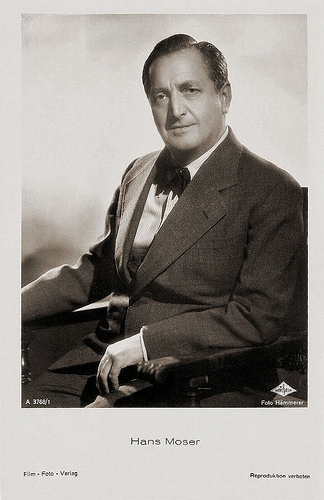
German postcard by Film-Foto-Verlag, no. 3768/1, 1941-1944. Photo: Wien Film / Hämmerer.
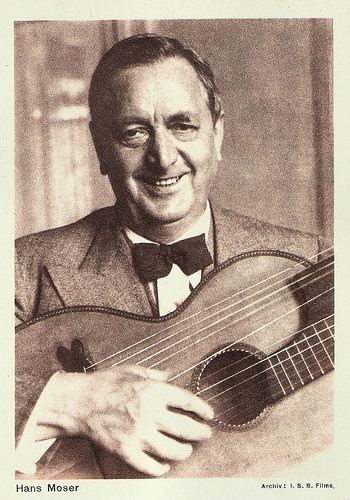
Austrian postcard by Eberle Verlag, Wien, no 27. Photo: I.S.B. Films.
Mumbling Indistinctly
Hans Moser was born Johann Julier in Vienna, Austria-Hungary (now Austria) in 1880. He was the third child of Academic sculptor Franz Julier and his wife Serafina, born Pöschl.
He grew up in the Margarethen district, attended secondary and commercial school and worked in accounting of a leather goods store in Vienna before he took paid acting lessons at Otto theatre school for a short period. Then he took language lessons from Josef Moser, a character player at the Vienna Court Theater. Julier decided to borrow his name and from then on he used as his stage name: Hans Moser.
In 1897, the 17-year-old Moser got his first theatre engagement and played smaller parts on different stages during the next years. Because of his shortness he often impersonated children. Moser returned to Vienna in 1910 where he married Blanca Hirschler the following year. In 1913, their daughter Margarethe was born.
From 1914 to 1918, he was a soldier and was deployed to the east front and to Isonzo, North Italy. After the war he became established as a character comedian and he played in the major theatres. In 1925 Max Reinhardt engaged him for Theater in der Josefstadt. Moser also performed at the Salzburg Festival between 1925 and 1927.
He played small parts in such silent films as Kleider machen Leute/Fine feathers make fine birds (Hans Steinhoff, 1921), Die Stadt ohne Juden/The City Without Jews (H.K. Breslauer, 1924) with Johannes Riemann , Ssanin (Friedrich Feher, Boris Nevolin, 1924) and Der Feldherrnhügel/The general's hill (Hans Otto, Erich Schönfelder, 1926).
Also his appearances in later silent films like Die Familie ohne Moral/The family without morality (Max Neufeld, 1927) and Spitzenhöschen und Schusterpech (Hans Otto, 1928) weren't very successful.
This did not change when the sound film was introduced. He played minor parts beside established Berliner comedians. In 1933 the tide turned in his favour when Willi Forst directed the first ‘Wiener filme’ (Viennese films).
In such films as Leise flehen meine Lieder/Lover Divine (Willi Forst, 1933) and Maskerade/Masquerade in Vienna (Willi Forst, 1934) audiences accepted Moser's mumble and nervous movements, and started to love it. In fact Moser became known for mumbling indistinctly for comic effect rather than pronouncing words and sentences clearly, and also for failing to finish his sentences.
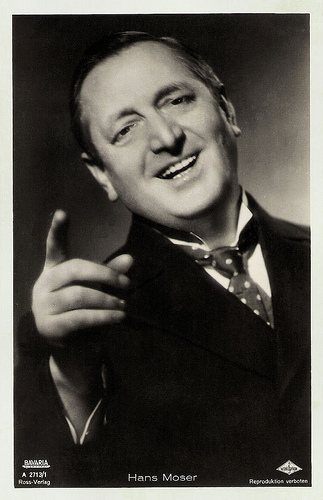
German postcard by Ross Verlag, no. A 2713/1, 1939-1940. Photo: Bavaria Filmkunst / Wien Film. Publicity still for Anton, der Letzte/Anthony the Last (E.W. Emo, 1939).
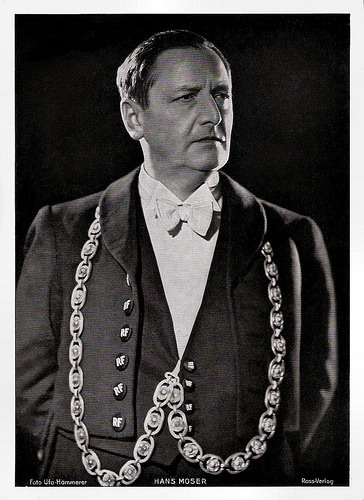
Big German card by Ross Verlag. Photo: Ufa / Hämmerer.
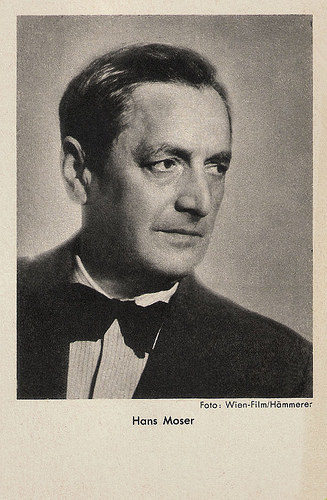
German postcard by Das Programm von Heute / Ross Verlag, Berlin. Photo: Wien-Film / Hämmerer.
Honest, Moral and Well-intentioned People
During the 1930s Hans Moser focused more and more on his film career and appeared less in the theatre. He often portrayed the man in the street, typically someone else's subordinate – servant, waiter, porter, shopkeeper, coachman, petty bureaucrat, etc.
Also always he played honest, moral and well-intentioned people who, unable to keep cool and think clearly in crucial situations, get themselves and everyone around them into all kinds of trouble. As the father of a beautiful daughter – often widowed – he was the stubborn one who realizes only at the end of the film, when all cases of mistaken identity have been cleared up and all secrets are revealed, that he has been terribly wrong all the time.
Popular films with Moser were Vorstadtvarieté/Suburban Cabaret (Werner Hochbaum, 1934), Der Himmel auf Erden/Heaven on Earth (E.W. Emo, 1935), Endstation/Last Stop (E.W. Emo, 1935), Familie Schimek/The Schimek Family (E.W. Emo, 1935), Das Gässchen zum Paradies/Paradise Road (Mac Fric, 1936), Burgtheater/Burg Theatre (Willi Forst, 1936), 13 Stühle/13 Chairs (E.W. Emo, 1938), Das Ekel/The Grouch (Hans Deppe, 1939), and Anton der Letzte/Anthony the Last (E.W. Emo, 1939).
During the war years followed Sieben Jahre Pech/Seven Years Hard Luck (Ernst Marischka, 1940), Wiener Blut/Vienna Blood (Willi Forst, 1942) and Einmal der liebe Herrgott sein/To Be God For Once (Hans H. Zerlett, 1942).
In these films Moser was the contrast to the composed North Germans Theo Lingen and Heinz Rühmann and fought out skirmishes with Adele Sandrock and Ida Wüst . Together with Paul Hörbiger , he headed the Viennese clan of film comedians that included Oskar Sima , Annie Rosar, Rudolf Carl, Leo Slezak, and Lucie Englisch . With Annie Rosar, he starred in seventeen films between 1933 and 1957.
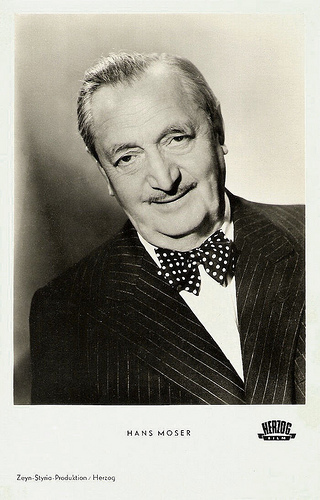
German postcard by Kunst und Bild, Berlin, no. A 481. Photo: Zeyn-Styria-Produktion / Herzog Film. Publicity still for Der Theodor im Fussbaltor/Theodor in the football goal (E.W. Emo, 1950).
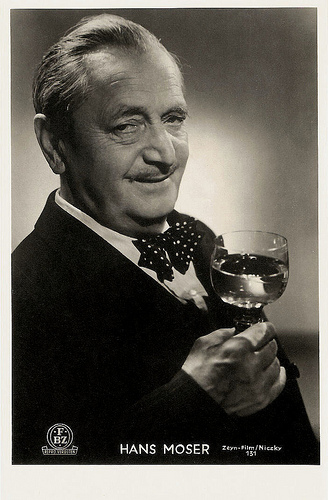
German postcard by F.B.Z., no. 131. Photo: Zeyn-Film / Niczky. Publicity still for Der Theodor im Fußballtor/Theodor in the football goal (E.W. Emo, 1950).
A Special Work Permission
During the Nazi regime, Moser had severe problems. His wife Blanca Hirschler was Jewish, and he refused to divorce her. It was only because of his great popularity that the regime allowed him to continue to appear in films. From 1933 he depended on a special work permission. His wife fled to Hungary in 1939 to avoid further trouble. After the war the couple reunited.
Moser continued his career in Austria, where he played at the theatre and appeared in such films as Der Herr Kanzleirat/Mr. Chancellery Council (Hubert Marischka, 1948), Hallo, Dienstmann/Hello Dienstmann (Franz Antel, 1952) and Der Onkel aus Amerika/His Majesty King Ballyhoo (Carl Boese, 1952).
He then acted in remakes of fading classics like Die Deutschmeister/A March for the Emperor (Ernst Marischka, 1955) starring Romy Schneider , Der Kongress tanzt/The Congress Dances (Franz Antel, 1955), and Die Drei von der Tankstelle/Three Friends and a gas station (Hans Wolff, 1955) with Adrian Hoven .
The quality of these films was not up to the standard of his films of the 1930s, and his star slowly began to sink. Only films like Ober, zahlen!/Waiter, the check! (E.W. Emo, 1957) and above all Herrn Josefs letzte Liebe/Mr. Josef’s last love (Hermann Kugelstadt, 1959) presented him again in his old top form.
Moser accepted unscrupulous nearly each film role he was offered and he had to make his jokes now with comedians of a new generation like Georg Thomalla, Trude Herr and Gunther Philipp. His film career ended in shallowness.
In the theatre Moser was also working as a serious actor, such as in Arthur Schnitzler’s play Liebelei (The Reckoning) – his first ever role in a production of Vienna’s Burgtheater that premiered in 1954, and was directed by Ernst Lothar.
Moser made his last stage performance in 1963, as a divine police law clerk in a production of Ferenc Molnár’s Liliom, directed by Kurt Meisel.
Hans Moser died of cancer in Vienna in 1964, aged 83. His continuing popularity is attested to by the fact that his style of speaking is still being parodied, often by very young entertainers.
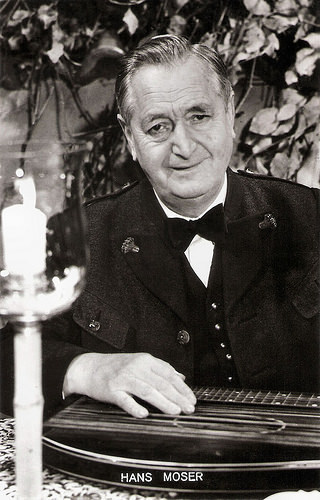
German postcard.
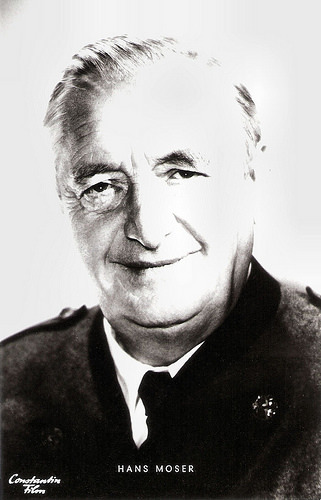
German postcard by Netter's Star Verlag, Berlin. Photo: Constantin Film.
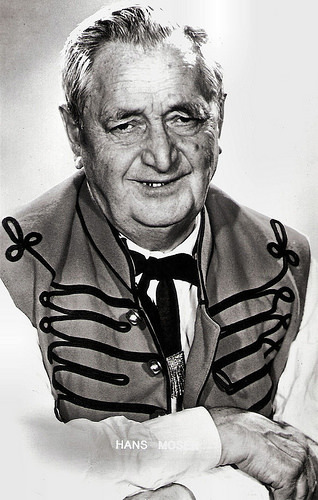
German postcard.
Sources: Thomas Staedeli (Cyranos), Filmportal.de, Wikipedia, and .

German postcard by Film-Foto-Verlag, no. 3768/1, 1941-1944. Photo: Wien Film / Hämmerer.

Austrian postcard by Eberle Verlag, Wien, no 27. Photo: I.S.B. Films.
Mumbling Indistinctly
Hans Moser was born Johann Julier in Vienna, Austria-Hungary (now Austria) in 1880. He was the third child of Academic sculptor Franz Julier and his wife Serafina, born Pöschl.
He grew up in the Margarethen district, attended secondary and commercial school and worked in accounting of a leather goods store in Vienna before he took paid acting lessons at Otto theatre school for a short period. Then he took language lessons from Josef Moser, a character player at the Vienna Court Theater. Julier decided to borrow his name and from then on he used as his stage name: Hans Moser.
In 1897, the 17-year-old Moser got his first theatre engagement and played smaller parts on different stages during the next years. Because of his shortness he often impersonated children. Moser returned to Vienna in 1910 where he married Blanca Hirschler the following year. In 1913, their daughter Margarethe was born.
From 1914 to 1918, he was a soldier and was deployed to the east front and to Isonzo, North Italy. After the war he became established as a character comedian and he played in the major theatres. In 1925 Max Reinhardt engaged him for Theater in der Josefstadt. Moser also performed at the Salzburg Festival between 1925 and 1927.
He played small parts in such silent films as Kleider machen Leute/Fine feathers make fine birds (Hans Steinhoff, 1921), Die Stadt ohne Juden/The City Without Jews (H.K. Breslauer, 1924) with Johannes Riemann , Ssanin (Friedrich Feher, Boris Nevolin, 1924) and Der Feldherrnhügel/The general's hill (Hans Otto, Erich Schönfelder, 1926).
Also his appearances in later silent films like Die Familie ohne Moral/The family without morality (Max Neufeld, 1927) and Spitzenhöschen und Schusterpech (Hans Otto, 1928) weren't very successful.
This did not change when the sound film was introduced. He played minor parts beside established Berliner comedians. In 1933 the tide turned in his favour when Willi Forst directed the first ‘Wiener filme’ (Viennese films).
In such films as Leise flehen meine Lieder/Lover Divine (Willi Forst, 1933) and Maskerade/Masquerade in Vienna (Willi Forst, 1934) audiences accepted Moser's mumble and nervous movements, and started to love it. In fact Moser became known for mumbling indistinctly for comic effect rather than pronouncing words and sentences clearly, and also for failing to finish his sentences.

German postcard by Ross Verlag, no. A 2713/1, 1939-1940. Photo: Bavaria Filmkunst / Wien Film. Publicity still for Anton, der Letzte/Anthony the Last (E.W. Emo, 1939).

Big German card by Ross Verlag. Photo: Ufa / Hämmerer.

German postcard by Das Programm von Heute / Ross Verlag, Berlin. Photo: Wien-Film / Hämmerer.
Honest, Moral and Well-intentioned People
During the 1930s Hans Moser focused more and more on his film career and appeared less in the theatre. He often portrayed the man in the street, typically someone else's subordinate – servant, waiter, porter, shopkeeper, coachman, petty bureaucrat, etc.
Also always he played honest, moral and well-intentioned people who, unable to keep cool and think clearly in crucial situations, get themselves and everyone around them into all kinds of trouble. As the father of a beautiful daughter – often widowed – he was the stubborn one who realizes only at the end of the film, when all cases of mistaken identity have been cleared up and all secrets are revealed, that he has been terribly wrong all the time.
Popular films with Moser were Vorstadtvarieté/Suburban Cabaret (Werner Hochbaum, 1934), Der Himmel auf Erden/Heaven on Earth (E.W. Emo, 1935), Endstation/Last Stop (E.W. Emo, 1935), Familie Schimek/The Schimek Family (E.W. Emo, 1935), Das Gässchen zum Paradies/Paradise Road (Mac Fric, 1936), Burgtheater/Burg Theatre (Willi Forst, 1936), 13 Stühle/13 Chairs (E.W. Emo, 1938), Das Ekel/The Grouch (Hans Deppe, 1939), and Anton der Letzte/Anthony the Last (E.W. Emo, 1939).
During the war years followed Sieben Jahre Pech/Seven Years Hard Luck (Ernst Marischka, 1940), Wiener Blut/Vienna Blood (Willi Forst, 1942) and Einmal der liebe Herrgott sein/To Be God For Once (Hans H. Zerlett, 1942).
In these films Moser was the contrast to the composed North Germans Theo Lingen and Heinz Rühmann and fought out skirmishes with Adele Sandrock and Ida Wüst . Together with Paul Hörbiger , he headed the Viennese clan of film comedians that included Oskar Sima , Annie Rosar, Rudolf Carl, Leo Slezak, and Lucie Englisch . With Annie Rosar, he starred in seventeen films between 1933 and 1957.

German postcard by Kunst und Bild, Berlin, no. A 481. Photo: Zeyn-Styria-Produktion / Herzog Film. Publicity still for Der Theodor im Fussbaltor/Theodor in the football goal (E.W. Emo, 1950).

German postcard by F.B.Z., no. 131. Photo: Zeyn-Film / Niczky. Publicity still for Der Theodor im Fußballtor/Theodor in the football goal (E.W. Emo, 1950).
A Special Work Permission
During the Nazi regime, Moser had severe problems. His wife Blanca Hirschler was Jewish, and he refused to divorce her. It was only because of his great popularity that the regime allowed him to continue to appear in films. From 1933 he depended on a special work permission. His wife fled to Hungary in 1939 to avoid further trouble. After the war the couple reunited.
Moser continued his career in Austria, where he played at the theatre and appeared in such films as Der Herr Kanzleirat/Mr. Chancellery Council (Hubert Marischka, 1948), Hallo, Dienstmann/Hello Dienstmann (Franz Antel, 1952) and Der Onkel aus Amerika/His Majesty King Ballyhoo (Carl Boese, 1952).
He then acted in remakes of fading classics like Die Deutschmeister/A March for the Emperor (Ernst Marischka, 1955) starring Romy Schneider , Der Kongress tanzt/The Congress Dances (Franz Antel, 1955), and Die Drei von der Tankstelle/Three Friends and a gas station (Hans Wolff, 1955) with Adrian Hoven .
The quality of these films was not up to the standard of his films of the 1930s, and his star slowly began to sink. Only films like Ober, zahlen!/Waiter, the check! (E.W. Emo, 1957) and above all Herrn Josefs letzte Liebe/Mr. Josef’s last love (Hermann Kugelstadt, 1959) presented him again in his old top form.
Moser accepted unscrupulous nearly each film role he was offered and he had to make his jokes now with comedians of a new generation like Georg Thomalla, Trude Herr and Gunther Philipp. His film career ended in shallowness.
In the theatre Moser was also working as a serious actor, such as in Arthur Schnitzler’s play Liebelei (The Reckoning) – his first ever role in a production of Vienna’s Burgtheater that premiered in 1954, and was directed by Ernst Lothar.
Moser made his last stage performance in 1963, as a divine police law clerk in a production of Ferenc Molnár’s Liliom, directed by Kurt Meisel.
Hans Moser died of cancer in Vienna in 1964, aged 83. His continuing popularity is attested to by the fact that his style of speaking is still being parodied, often by very young entertainers.

German postcard.

German postcard by Netter's Star Verlag, Berlin. Photo: Constantin Film.

German postcard.
Sources: Thomas Staedeli (Cyranos), Filmportal.de, Wikipedia, and .
Published on July 14, 2017 22:00
July 13, 2017
Regina Beyer
German actress Regina Beyer (1947) starred in many DEFA films of the 1960s and 1970s, but she became most popular with her TV appearances for the East-German Television (DFF). She also worked for the theatre and the radio.
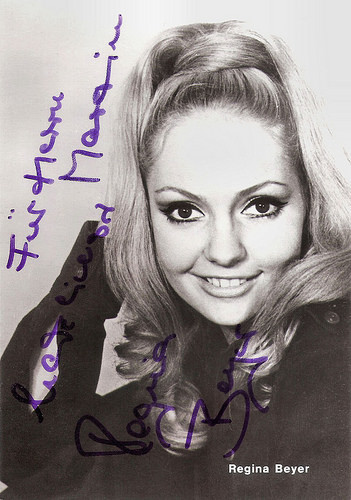
East-German postcard by VEB Progress Film-Vertrieb, Berlin, no. 90/70, 1970. Photo: Günter Linke.
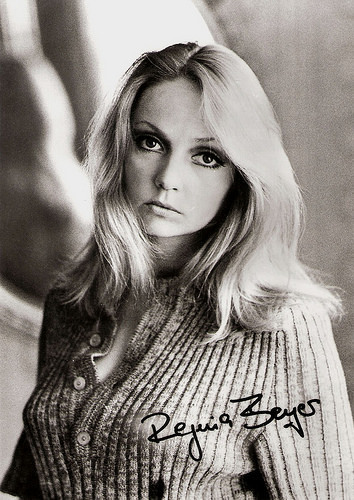
East-German postcard by VEB Progress Film-Vertrieb, Berlin, no. 152/71, 1971. Photo: Günter Linke.
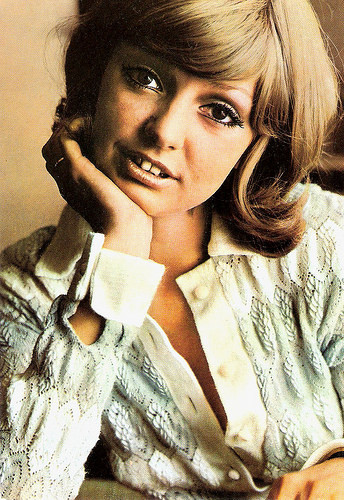
East-German postcard by VEB Progress Film-Vertrieb, Berlin, no. 1/F/72. Photo: Günter Linke.
A national celebrity in the former GDR
Regina Beyer was born in Berlin in 1947. She was the daughter of an engineer and an attorney.
After finishing school, she at first started an apprenticeship as a film technician and worked as a photo model.
Director Rolf Losansky engaged her for his short film Motorradhelden/Motorcycle heroes (Rolf Losansky,1964). Although she only played a minor role in this film, Beyer decided to become an actress.
She began her acting studies in 1965 at the Hochschule für Film und Fernsehen Potsdam-Babelsberg and in the meanwhile she acted in various DEFA features. These included such as films as Das Mädchen auf dem Brett/The Girl on the Board (Kurt Maetzig, 1967) and the Swashbuckler Hauptmann Florian von der Mühle/Captain Florian of the Mill (Werner W. Wallroth, 1968) starring Manfred Krug . Her leading role in this film made her a national celebrity in the former GDR.
After completing her studies in 1969, she became an ensemble member of the DEFA and remained there till 1990. Her films included the love story Im Himmel ist doch Jahrmarkt (Rolf Losansky, 1969), with Beyer as parachutist Gritta, and Anflug Alpha 1 (Janos Veiczi, 1971), with Beyer as Anka who has to stand by her boyfriend, an air force lieutenant, after a crash.
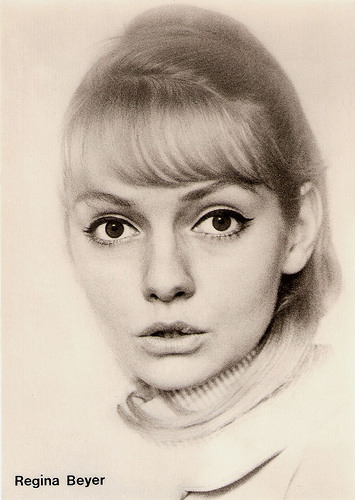
East-German postcard by VEB Progress Film-Vertrieb, Berlin, no. 3338, 1969. Photo: Schwarz.
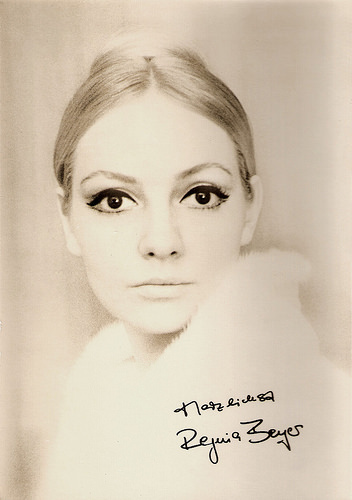
Big East-German card by VEB Progress Film-Vertrieb, Berlin, no. 114/69, 1969. Photo: Schwarz.
Fresh and freely taking their lives in their own hands
Regina Beyer’s trademark characters in the DEFA films of the early 1970s were emancipated young women, who fresh and freely took their lives in their own hands.
She played secretaries and electricians, but also convinced when she portrayed historical personalities such as Queen Luise.
Later Beyer worked intensively for the television of the GDR. In addition to countless television films and TV series such as Egmont (Helmut Schiemann, 1974), she became the favourite actress of director Helmut Krätzig. He directed her in episodes of the popular television series Polizeiruf 110/Police Call 110 (1976-1990).
From the 1970s on, Regina Beyer was also regularly seen on stage and studied theatre studies at the Theaterhochschule Hans Otto in Leipzig from 1975 to 1979.
After the reunification of Germany in 1990, Beyer continued her work as an actress. Although her contract with the DEFA stopped, she appeared in the film comedy Cosima's Lexikon/Cosima’s Lexicon (Peter Kahane, 1992) with Iris Berben, and in TV series like Elbflorenz and Liebling Kreuzberg.
Today Regina Beyer lives with her companion, the actor Volkmar Kleinert in Berlin. In her first marriage, she was married to the actor Frank Obermann, with whom she has a daughter.
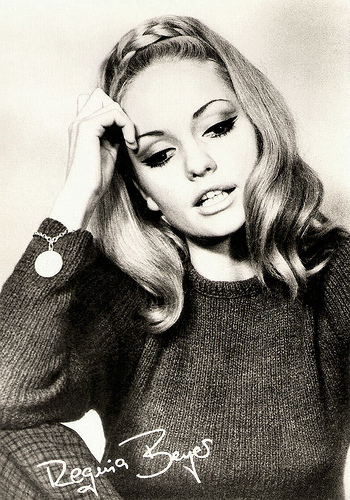
East-German postcard by VEB Progress Film-Vertrieb, Berlin, no. 69/70, 1970. Photo: Günter Linke.

East-German postcard by VEB Progress Film-Vertrieb, Berlin, no. 114/73, 1973. Photo: Günter Linke.
Sources: Filmportal.de, Film-zeit.de (German), Wikipedia (German), and .

East-German postcard by VEB Progress Film-Vertrieb, Berlin, no. 90/70, 1970. Photo: Günter Linke.

East-German postcard by VEB Progress Film-Vertrieb, Berlin, no. 152/71, 1971. Photo: Günter Linke.

East-German postcard by VEB Progress Film-Vertrieb, Berlin, no. 1/F/72. Photo: Günter Linke.
A national celebrity in the former GDR
Regina Beyer was born in Berlin in 1947. She was the daughter of an engineer and an attorney.
After finishing school, she at first started an apprenticeship as a film technician and worked as a photo model.
Director Rolf Losansky engaged her for his short film Motorradhelden/Motorcycle heroes (Rolf Losansky,1964). Although she only played a minor role in this film, Beyer decided to become an actress.
She began her acting studies in 1965 at the Hochschule für Film und Fernsehen Potsdam-Babelsberg and in the meanwhile she acted in various DEFA features. These included such as films as Das Mädchen auf dem Brett/The Girl on the Board (Kurt Maetzig, 1967) and the Swashbuckler Hauptmann Florian von der Mühle/Captain Florian of the Mill (Werner W. Wallroth, 1968) starring Manfred Krug . Her leading role in this film made her a national celebrity in the former GDR.
After completing her studies in 1969, she became an ensemble member of the DEFA and remained there till 1990. Her films included the love story Im Himmel ist doch Jahrmarkt (Rolf Losansky, 1969), with Beyer as parachutist Gritta, and Anflug Alpha 1 (Janos Veiczi, 1971), with Beyer as Anka who has to stand by her boyfriend, an air force lieutenant, after a crash.

East-German postcard by VEB Progress Film-Vertrieb, Berlin, no. 3338, 1969. Photo: Schwarz.

Big East-German card by VEB Progress Film-Vertrieb, Berlin, no. 114/69, 1969. Photo: Schwarz.
Fresh and freely taking their lives in their own hands
Regina Beyer’s trademark characters in the DEFA films of the early 1970s were emancipated young women, who fresh and freely took their lives in their own hands.
She played secretaries and electricians, but also convinced when she portrayed historical personalities such as Queen Luise.
Later Beyer worked intensively for the television of the GDR. In addition to countless television films and TV series such as Egmont (Helmut Schiemann, 1974), she became the favourite actress of director Helmut Krätzig. He directed her in episodes of the popular television series Polizeiruf 110/Police Call 110 (1976-1990).
From the 1970s on, Regina Beyer was also regularly seen on stage and studied theatre studies at the Theaterhochschule Hans Otto in Leipzig from 1975 to 1979.
After the reunification of Germany in 1990, Beyer continued her work as an actress. Although her contract with the DEFA stopped, she appeared in the film comedy Cosima's Lexikon/Cosima’s Lexicon (Peter Kahane, 1992) with Iris Berben, and in TV series like Elbflorenz and Liebling Kreuzberg.
Today Regina Beyer lives with her companion, the actor Volkmar Kleinert in Berlin. In her first marriage, she was married to the actor Frank Obermann, with whom she has a daughter.

East-German postcard by VEB Progress Film-Vertrieb, Berlin, no. 69/70, 1970. Photo: Günter Linke.

East-German postcard by VEB Progress Film-Vertrieb, Berlin, no. 114/73, 1973. Photo: Günter Linke.
Sources: Filmportal.de, Film-zeit.de (German), Wikipedia (German), and .
Published on July 13, 2017 22:00
July 12, 2017
Evelyn Holt
Evelyn Holt (1908-2001) was a highly popular German film actress in the late silent and the early sound era. The rise of the Nazis finished her blossoming film career.

German postcard by Ross Verlag, no. 4769/1, 1929-1930. Photo: Atelier Balázs, Berlin.

Austrian postcard by Iris Verlag, no. 946. Photo: Lux Film Verleih.

Austrian postcard by Iris Verlag, no. 947. Photo: National.

German postcard by Ross Verlag, no. 1780/1, 1927-1928. Photo: Alex Binder, Berlin.
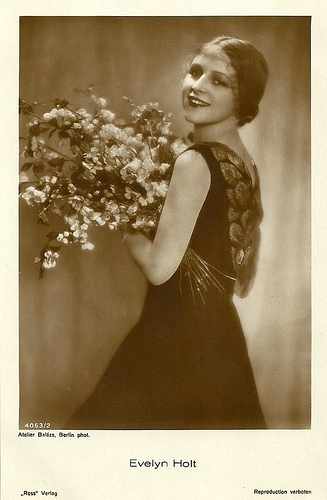
German postcard by Ross Verlag, no. 4063/2, 1929-1930. Photo: Atelier Balázs, Berlin.
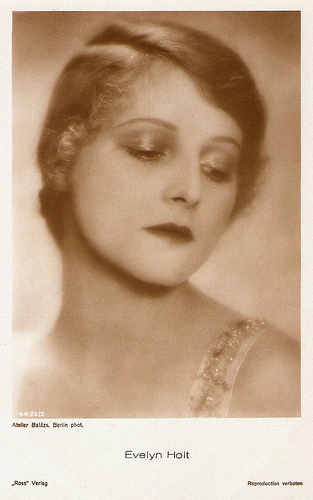
German postcard by Ross Verlag, no. 4422/2, 1929-1930. Photo: Atelier Balázs, Berlin.
Jane Eyre
Evelyn Holt was born as Evelyn Sklarz in Berlin in 1908. She was the daughter of a journalist.
Holt started her film career at UFA even before turning 20. The very attractive girl soon became the star of many German films of the late silent era, and was soon paired with famous actors like Hans Albers .
In the crime film Spitzen/Have an eye (Holger-Madsen, 1926) starring Elisabeth Pinajeff , she still had a secondary part.
In her second film the Charlotte Brönte adaptation Die Waise von Lowood/The Orphan of Lowood (Kurt aka Curtis Bernhardt, 1926), she played the title part of Jane Eyre, while Olaf Fönss played Rochester.
Other silent films were the Arthur Schnitzler adaptation Liebelei/Flirtation (Jakob & Luise Fleck, 1927) with Fred Louis Lerch and Henry Stuart , Die elf Teufel (Zoltan Korda, Carl Boese, 1927) starring Gustav Fröhlich , and Frauenarzt Dr. Schäfer/ Gynecologist Doctor Schaefer (Jakob & Luise Fleck, 1928) starring Iván Petrovich .
In the German-Austrian-British coproduction Der fesche Husar/The Bold Dragoon (Géza von Bolvary, 1928) her co-star was the British matinee idol Ivor Novello , and in Ein Mädel und drei Clowns/The Three Kings (Hans Steinhoff, 1928) she played opposite two other British stars, Henry Edwards and Warwick Ward .
Her films were often directed by the husband and wife team of Jakob and Luise Fleck. They worked together at Das Recht auf Liebe/The Right on Love (Jakob & Louise Fleck, 1929) which was scripted by Magnus Hirschfeld, and also at the crime film Einbruch im Bankhaus Reichenbach/Burglary in the banking house Reichenbach (Jakob & Louise Fleck, 1930). In total Holt appeared in nearly 20 silent films.
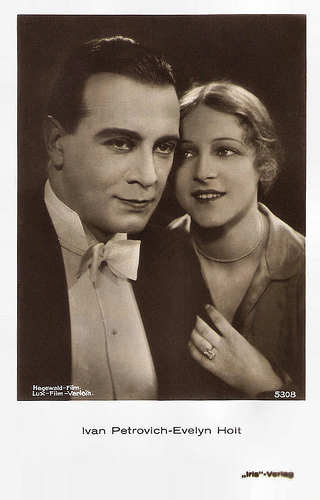
German postcard by Iris Verlag, no. 5308. Photo: Hegewald-Film / Lux-Film-Verleih. Publicity still for Frauenarzt Dr. Schäfer/ Gynecologist Doctor Schaefer (Jacob Fleck, Luise Fleck, 1928) with Iván Petrovich .

German postcard by Ross Verlag, no. 3303/1, 1928-1929. Photo: Hegewald-Film.
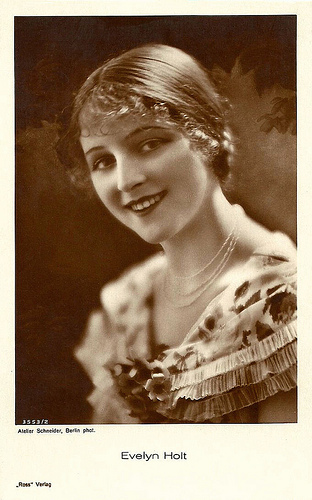
German postcard by Ross Verlag, no. 3553/2, 1928-1929. Photo: Atelier Schneider, Berlin.

German postcard by Ross Verlag, no. 5068/2, 1930-1931. Photo: Atelier Balázs, Berlin.
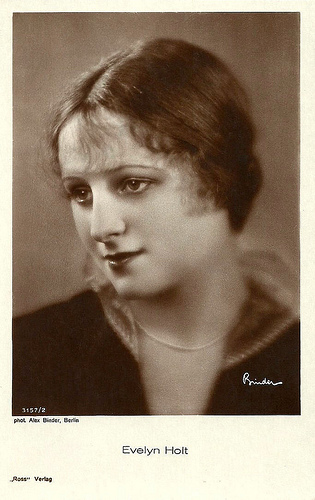
German postcard by Ross Verlag, no. 3157/2, 1928-1929. Photo: Alex Binder, Berlin.
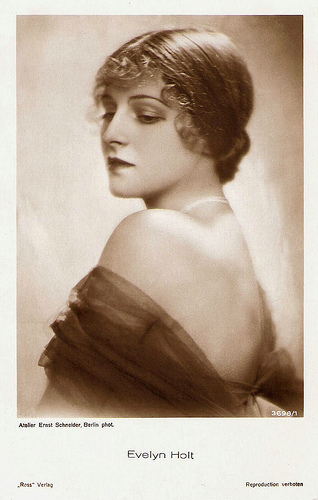
German postcard by Ross Verlag, no. 3688/1, 1928-1929. Photo: Ernst Schneider, Berlin.
Soubrette
Das Wolgamädchen/The Wolga Girl (Robert Wohlmuth, 1930) was probably Evelyn Holt’s first sound film. It costarred Igo Sym en Ellen Schaak. Seven more sound films followed.
Namensheirat/Marriage in Name Only (Heinz Paul, 1930) was scripted by former silent film star Hella Moja . Holt played the lead, and there were many other silent stars in the cast, including Oscar Marion , Grit Haid , Walter Rilla , Hans Mierendorff and Ida Wüst .
Holt again played the lead in Eine Stunde Glück/An Hour of Happiness (1931), directed by former silent star Wilhelm Dieterle , who soon after would pursue a career as director in the US under the name of William Dieterle . He also played the male lead in Eine Stunde Glück. Das Ekel/The Scoundrel (Eugen Schüfftan, Franz Wenzler, 1931) was a comedy on a working day in Berlin.
Holt’s last features were the unemployment comedy Drei von der Stempelstelle/The Three of the Stamp Place (Eugen Thiele, 1932) starring Fritz Kampers, Paul Kemp and Adolf Wohlbrück (the future Anton Walbrook ); and the car races film Kampf/Battle (Erich Schonfelder, Haro van Peski, 1932) starring Grand Prix car driver Manfred von Brauchitsch.
In 1933 she also did a commercial for Sanella. After singing lessons Holt was engaged as soubrette at the Große Schauspielhaus in Berlin in 1931.
After only six successful years, Adolf Hitler’s coming to power in 1933, abruptly ended her profession as film actress. The reason: her original name looked too Jewish. She managed to survive by a career as soubrette at the Komische Oper in Berlin, but when she married the Jewish publisher Felix Guggenheim in 1936, her stage career was halted as well.
In 1938 the couple emigrated first to Switzerland, then in 1940 to Britain, and finally to the US. There Felix Guggenheim became the Exil literature publisher of authors such as Thomas Mann, Franz Werfel, Lion Feuchtwanger and Alfred Döblin. Evelyn Holt stayed in the US until her death in Los Angeles in 2001, but she never performed in a film again.
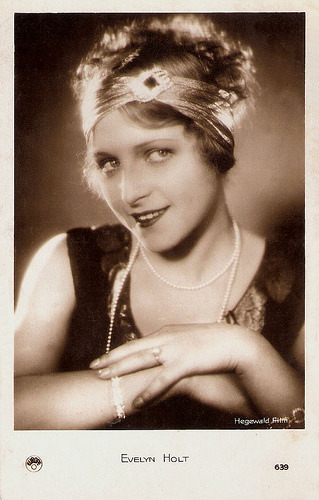
French postcard by Europe, no. 639. Photo: Hegewald Film.
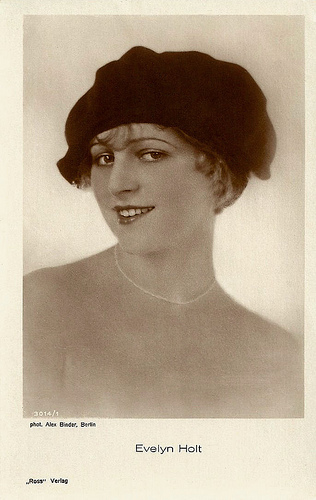
German postcard by Ross Verlag, no. 3014/1, 1928-1929. Photo: Alex Binder, Berlin.
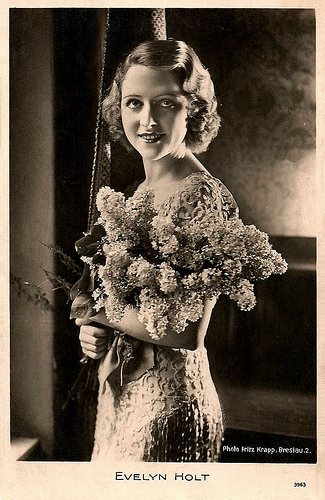
German postcard, no. 3963. Photo: Fritz Krapp, Breslau (now Wroclaw, Poland).
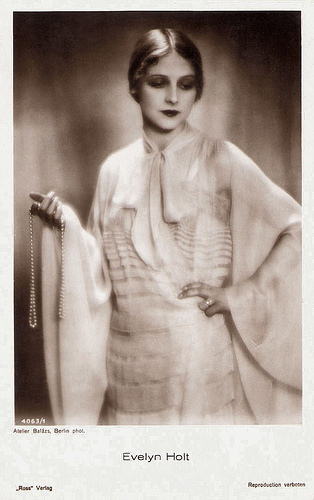
German postcard by Ross Verlag, no. 4063/1, 1929-1930. Photo: Atelier Balázs, Berlin.
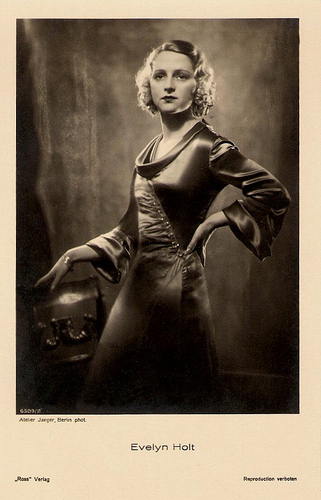
German postcard by Ross Verlag, no. 6503, 1931-1932. Photo: Atelier Jaeger, Berlin.
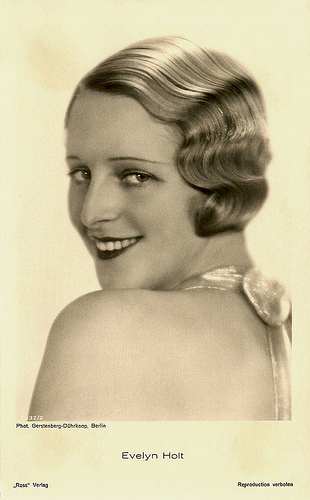
German postcard by Ross Verlag, no. 7332/2, 1932-1933. Photo: Gerstenberg-Dührkoop.
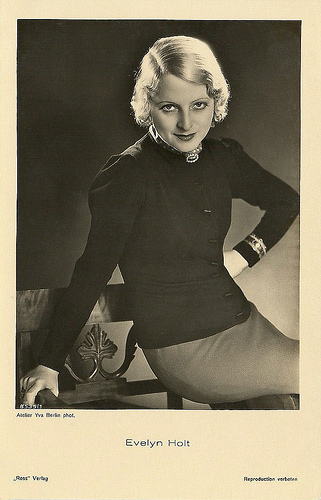
German postcard by Ross Verlag, no. 8535/1, 1933-1934. Photo: Yva, Berlin. Collection: Didier Hanson.
Sources: Thomas Staedeli (Cyranos), Filmportal.de, Wikipedia (German), and .

German postcard by Ross Verlag, no. 4769/1, 1929-1930. Photo: Atelier Balázs, Berlin.

Austrian postcard by Iris Verlag, no. 946. Photo: Lux Film Verleih.

Austrian postcard by Iris Verlag, no. 947. Photo: National.

German postcard by Ross Verlag, no. 1780/1, 1927-1928. Photo: Alex Binder, Berlin.

German postcard by Ross Verlag, no. 4063/2, 1929-1930. Photo: Atelier Balázs, Berlin.

German postcard by Ross Verlag, no. 4422/2, 1929-1930. Photo: Atelier Balázs, Berlin.
Jane Eyre
Evelyn Holt was born as Evelyn Sklarz in Berlin in 1908. She was the daughter of a journalist.
Holt started her film career at UFA even before turning 20. The very attractive girl soon became the star of many German films of the late silent era, and was soon paired with famous actors like Hans Albers .
In the crime film Spitzen/Have an eye (Holger-Madsen, 1926) starring Elisabeth Pinajeff , she still had a secondary part.
In her second film the Charlotte Brönte adaptation Die Waise von Lowood/The Orphan of Lowood (Kurt aka Curtis Bernhardt, 1926), she played the title part of Jane Eyre, while Olaf Fönss played Rochester.
Other silent films were the Arthur Schnitzler adaptation Liebelei/Flirtation (Jakob & Luise Fleck, 1927) with Fred Louis Lerch and Henry Stuart , Die elf Teufel (Zoltan Korda, Carl Boese, 1927) starring Gustav Fröhlich , and Frauenarzt Dr. Schäfer/ Gynecologist Doctor Schaefer (Jakob & Luise Fleck, 1928) starring Iván Petrovich .
In the German-Austrian-British coproduction Der fesche Husar/The Bold Dragoon (Géza von Bolvary, 1928) her co-star was the British matinee idol Ivor Novello , and in Ein Mädel und drei Clowns/The Three Kings (Hans Steinhoff, 1928) she played opposite two other British stars, Henry Edwards and Warwick Ward .
Her films were often directed by the husband and wife team of Jakob and Luise Fleck. They worked together at Das Recht auf Liebe/The Right on Love (Jakob & Louise Fleck, 1929) which was scripted by Magnus Hirschfeld, and also at the crime film Einbruch im Bankhaus Reichenbach/Burglary in the banking house Reichenbach (Jakob & Louise Fleck, 1930). In total Holt appeared in nearly 20 silent films.

German postcard by Iris Verlag, no. 5308. Photo: Hegewald-Film / Lux-Film-Verleih. Publicity still for Frauenarzt Dr. Schäfer/ Gynecologist Doctor Schaefer (Jacob Fleck, Luise Fleck, 1928) with Iván Petrovich .

German postcard by Ross Verlag, no. 3303/1, 1928-1929. Photo: Hegewald-Film.

German postcard by Ross Verlag, no. 3553/2, 1928-1929. Photo: Atelier Schneider, Berlin.

German postcard by Ross Verlag, no. 5068/2, 1930-1931. Photo: Atelier Balázs, Berlin.

German postcard by Ross Verlag, no. 3157/2, 1928-1929. Photo: Alex Binder, Berlin.

German postcard by Ross Verlag, no. 3688/1, 1928-1929. Photo: Ernst Schneider, Berlin.
Soubrette
Das Wolgamädchen/The Wolga Girl (Robert Wohlmuth, 1930) was probably Evelyn Holt’s first sound film. It costarred Igo Sym en Ellen Schaak. Seven more sound films followed.
Namensheirat/Marriage in Name Only (Heinz Paul, 1930) was scripted by former silent film star Hella Moja . Holt played the lead, and there were many other silent stars in the cast, including Oscar Marion , Grit Haid , Walter Rilla , Hans Mierendorff and Ida Wüst .
Holt again played the lead in Eine Stunde Glück/An Hour of Happiness (1931), directed by former silent star Wilhelm Dieterle , who soon after would pursue a career as director in the US under the name of William Dieterle . He also played the male lead in Eine Stunde Glück. Das Ekel/The Scoundrel (Eugen Schüfftan, Franz Wenzler, 1931) was a comedy on a working day in Berlin.
Holt’s last features were the unemployment comedy Drei von der Stempelstelle/The Three of the Stamp Place (Eugen Thiele, 1932) starring Fritz Kampers, Paul Kemp and Adolf Wohlbrück (the future Anton Walbrook ); and the car races film Kampf/Battle (Erich Schonfelder, Haro van Peski, 1932) starring Grand Prix car driver Manfred von Brauchitsch.
In 1933 she also did a commercial for Sanella. After singing lessons Holt was engaged as soubrette at the Große Schauspielhaus in Berlin in 1931.
After only six successful years, Adolf Hitler’s coming to power in 1933, abruptly ended her profession as film actress. The reason: her original name looked too Jewish. She managed to survive by a career as soubrette at the Komische Oper in Berlin, but when she married the Jewish publisher Felix Guggenheim in 1936, her stage career was halted as well.
In 1938 the couple emigrated first to Switzerland, then in 1940 to Britain, and finally to the US. There Felix Guggenheim became the Exil literature publisher of authors such as Thomas Mann, Franz Werfel, Lion Feuchtwanger and Alfred Döblin. Evelyn Holt stayed in the US until her death in Los Angeles in 2001, but she never performed in a film again.

French postcard by Europe, no. 639. Photo: Hegewald Film.

German postcard by Ross Verlag, no. 3014/1, 1928-1929. Photo: Alex Binder, Berlin.

German postcard, no. 3963. Photo: Fritz Krapp, Breslau (now Wroclaw, Poland).

German postcard by Ross Verlag, no. 4063/1, 1929-1930. Photo: Atelier Balázs, Berlin.

German postcard by Ross Verlag, no. 6503, 1931-1932. Photo: Atelier Jaeger, Berlin.

German postcard by Ross Verlag, no. 7332/2, 1932-1933. Photo: Gerstenberg-Dührkoop.

German postcard by Ross Verlag, no. 8535/1, 1933-1934. Photo: Yva, Berlin. Collection: Didier Hanson.
Sources: Thomas Staedeli (Cyranos), Filmportal.de, Wikipedia (German), and .
Published on July 12, 2017 22:00
July 11, 2017
Sandra Milo
Italian actress Sandra Milo (1933) is best known for her roles in Federico Fellini's 8½ (1963) and Giulietta degli spiriti/Juliet of the Spirits (1965), but she also worked with the famous directors Antonio Pietrangeli and Roberto Rossellini. She won the Silver Ribbon Best Supporting Actress award for both 8½ and Juliet of the Spirits.
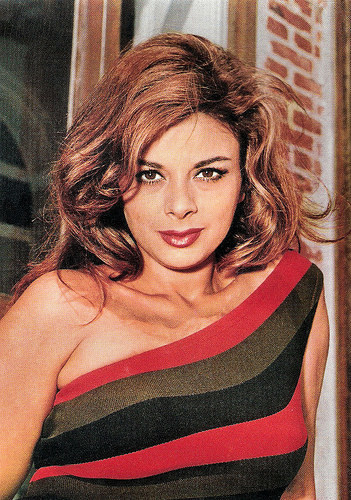
Italian postcard by Rotalfoto, no. 98.
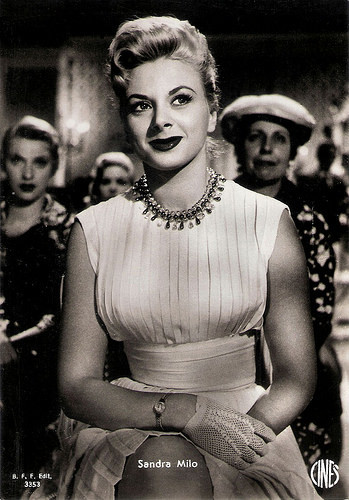
Italian postcard by B.F.F. Edit., no. 3353. Photo: Cines.
Saucy comedies and steamy melodramas
Sandra Milo was born Elena Salvatrice Greco in Tunis, Tunisia in 1933.
She made her film debut alongside Alberto Sordi in Lo scapolo/The Bachelor (Antonio Pietrangeli, 1955). Milo mostly performed in saucy comedies and steamy melodramas.
Such films included Mio figlio Nerone/Nero's Mistress (Steno, 1956) with Alberto Sordi and Gloria Swanson , Les aventures d'Arsène Lupin/The Adventures of Arsène Lupin (Jacques Becker, 1957) with Robert Lamoureux , Le miroir à deux faces/The Mirror Has Two Faces (André Cayate, 1958) starring Michèle Morgan , and Totò nella luna/Toto in the Moon (Steno, 1958) with Totò and Sylva Koscina .
Gary Brumburgh at IMDb : “bosomy, scintillating, dark-haired Tunisian leading lady Sandra Milo played bored patricians, manipulative mistresses and other enticing ladies of questionable morals with typical sensuous flare.”
Her first major role came thanks to the producer Moris Ergas, in Il generale Della Rovere/General Della Rovere (1959), directed by Roberto Rossellini and featuring Vittorio De Sica . She starred opposite Lino Ventura in two French thrillers, Un témoin dans la ville/Witness in the City (Edouard Molinaro, 1959), and Classe tous risques/The Big Risk (Claude Sautet, 1960).
Antonio Pietrangeli directed her again in Adua e le compagne/Adua and Her Friends (1960), a comedy about four unemployed prostitutes who decide to go into business running a restaurant, and in Fantasmi a Roma/Ghosts of Rome (1961), both with Marcello Mastroianni .
She also appeared opposite Laurent Terzieff in Vanina Vanini (Roberto Rossellini, 1961), based on a short story by Stendhal. Rossellini's career was cut short after the film received harsh criticism at the Venice Festival. Milo married producer Moris Ergas with whom she had a daughter Deborah. After her marriage, she retired from her acting career.
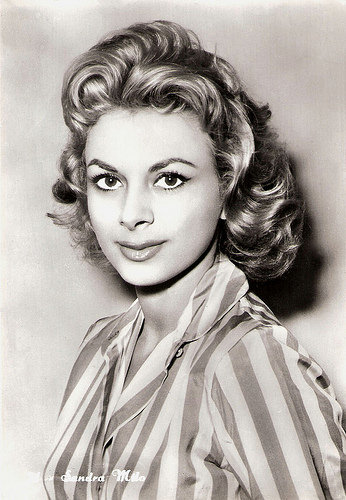
Italian postcard by Turismofoto, no. 71.
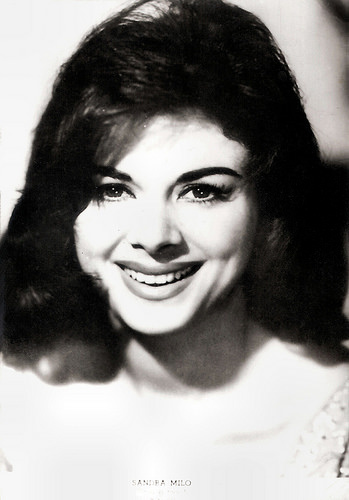
Small Romanian collectors card, no. 12.
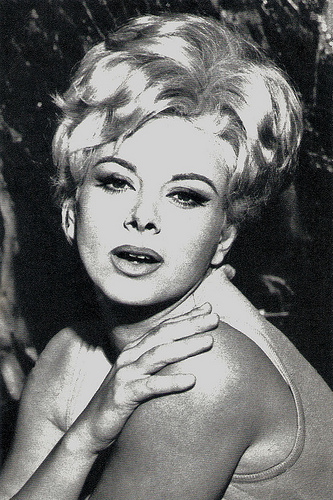
Romanian postcard by Casa Filmului Acin, no. 94.
A flesh and blood incarnation of Satan
Then Sandra Milo was discovered by Federico Fellini. Although she was reluctant to make a comeback, Fellini convinced Milo to take on the role of the sexy, lightheaded mistress opposite Marcello Mastroianni in 8½ (1963). 8½ won an Academy Award for Best Foreign-Language Film, as well as the Grand Prize at the Moscow Film Festival, and was one of the most influential and commercially successful European art movies of the 1960s.
After this success, she reunited with director Antonio Pietrangeli for La visita/The Visit (1963) with François Périer .
Fellini then directed her opposite Giulietta Masina in Giulietta degli spiriti/Juliet of the Spirits (Federico Fellini, 1965). She played Giulietta’s neighbour, Suzy, a highly, eccentric pleasure-seeker who lives in a sensual playhouse and who may or may not be a flesh and blood incarnation of Satan.
David Anderson in his review at Bunched Undies : "Federico Fellini’s Juliet of the Spirits remains one of the esteemed director’s most fanciful and entertaining films; its sparkling joys untarnished by the passage of time. (...) Clearly, Juliet of the Spirits is one of Italy’s first feminist films from a modern perspective. While Fellini made several films with Masina - and in all of them she faces significant obstacles - this is the first to loudly proclaim that a woman doesn’t necessarily need a husband to find happiness and, in some cases, she may be better off without one. "
Most of Milo’s following endeavours however were second-rate films. She retired again from acting in 1968, only to make a second comeback in 1979. Her roles have shifted from that of the temptress to more stern middle-aged women. She appeared in Pupi Avati’s romantic drama Il Cuore Altrove/A Heart Elsewhere (2003) with Neri Marcoré and Giancarlo Giannini.
In 2006-2007 she toured Italy with the theatrical adaptation of 8 Femmes/8 Women. In second marriage, she married Ottavio De Lollis with whom she had two sons, Ciro and Azzurra. Sandra Milo's latest film is Il velo di Maya/The veil of Maya (Elisabetta Rocchetti, 2017).
DVD-trailer 8½ (1963). Source: Screenbound Pictures (YouTube).
Trailer Giulietta degli spiriti/Juliet of the Spirits (1965). Source: Argent Films (YouTube).
Sources: David Anderson (Bunched Undies), (IMDb), Hal Erickson (AllMovie), Wikipedia and .

Italian postcard by Rotalfoto, no. 98.

Italian postcard by B.F.F. Edit., no. 3353. Photo: Cines.
Saucy comedies and steamy melodramas
Sandra Milo was born Elena Salvatrice Greco in Tunis, Tunisia in 1933.
She made her film debut alongside Alberto Sordi in Lo scapolo/The Bachelor (Antonio Pietrangeli, 1955). Milo mostly performed in saucy comedies and steamy melodramas.
Such films included Mio figlio Nerone/Nero's Mistress (Steno, 1956) with Alberto Sordi and Gloria Swanson , Les aventures d'Arsène Lupin/The Adventures of Arsène Lupin (Jacques Becker, 1957) with Robert Lamoureux , Le miroir à deux faces/The Mirror Has Two Faces (André Cayate, 1958) starring Michèle Morgan , and Totò nella luna/Toto in the Moon (Steno, 1958) with Totò and Sylva Koscina .
Gary Brumburgh at IMDb : “bosomy, scintillating, dark-haired Tunisian leading lady Sandra Milo played bored patricians, manipulative mistresses and other enticing ladies of questionable morals with typical sensuous flare.”
Her first major role came thanks to the producer Moris Ergas, in Il generale Della Rovere/General Della Rovere (1959), directed by Roberto Rossellini and featuring Vittorio De Sica . She starred opposite Lino Ventura in two French thrillers, Un témoin dans la ville/Witness in the City (Edouard Molinaro, 1959), and Classe tous risques/The Big Risk (Claude Sautet, 1960).
Antonio Pietrangeli directed her again in Adua e le compagne/Adua and Her Friends (1960), a comedy about four unemployed prostitutes who decide to go into business running a restaurant, and in Fantasmi a Roma/Ghosts of Rome (1961), both with Marcello Mastroianni .
She also appeared opposite Laurent Terzieff in Vanina Vanini (Roberto Rossellini, 1961), based on a short story by Stendhal. Rossellini's career was cut short after the film received harsh criticism at the Venice Festival. Milo married producer Moris Ergas with whom she had a daughter Deborah. After her marriage, she retired from her acting career.

Italian postcard by Turismofoto, no. 71.

Small Romanian collectors card, no. 12.

Romanian postcard by Casa Filmului Acin, no. 94.
A flesh and blood incarnation of Satan
Then Sandra Milo was discovered by Federico Fellini. Although she was reluctant to make a comeback, Fellini convinced Milo to take on the role of the sexy, lightheaded mistress opposite Marcello Mastroianni in 8½ (1963). 8½ won an Academy Award for Best Foreign-Language Film, as well as the Grand Prize at the Moscow Film Festival, and was one of the most influential and commercially successful European art movies of the 1960s.
After this success, she reunited with director Antonio Pietrangeli for La visita/The Visit (1963) with François Périer .
Fellini then directed her opposite Giulietta Masina in Giulietta degli spiriti/Juliet of the Spirits (Federico Fellini, 1965). She played Giulietta’s neighbour, Suzy, a highly, eccentric pleasure-seeker who lives in a sensual playhouse and who may or may not be a flesh and blood incarnation of Satan.
David Anderson in his review at Bunched Undies : "Federico Fellini’s Juliet of the Spirits remains one of the esteemed director’s most fanciful and entertaining films; its sparkling joys untarnished by the passage of time. (...) Clearly, Juliet of the Spirits is one of Italy’s first feminist films from a modern perspective. While Fellini made several films with Masina - and in all of them she faces significant obstacles - this is the first to loudly proclaim that a woman doesn’t necessarily need a husband to find happiness and, in some cases, she may be better off without one. "
Most of Milo’s following endeavours however were second-rate films. She retired again from acting in 1968, only to make a second comeback in 1979. Her roles have shifted from that of the temptress to more stern middle-aged women. She appeared in Pupi Avati’s romantic drama Il Cuore Altrove/A Heart Elsewhere (2003) with Neri Marcoré and Giancarlo Giannini.
In 2006-2007 she toured Italy with the theatrical adaptation of 8 Femmes/8 Women. In second marriage, she married Ottavio De Lollis with whom she had two sons, Ciro and Azzurra. Sandra Milo's latest film is Il velo di Maya/The veil of Maya (Elisabetta Rocchetti, 2017).
DVD-trailer 8½ (1963). Source: Screenbound Pictures (YouTube).
Trailer Giulietta degli spiriti/Juliet of the Spirits (1965). Source: Argent Films (YouTube).
Sources: David Anderson (Bunched Undies), (IMDb), Hal Erickson (AllMovie), Wikipedia and .
Published on July 11, 2017 22:00
July 10, 2017
Alexander Girardi
Austrian comedian, character actor and tenor Alexander Girardi (1850-1918) was famous for his roles in plays by Ferdinand Raimund as well as for his performance of comic roles in operettas by Johann Strauß, Karl Millöcker and Franz Lehar. The multitalent was also the first Austrian film star.
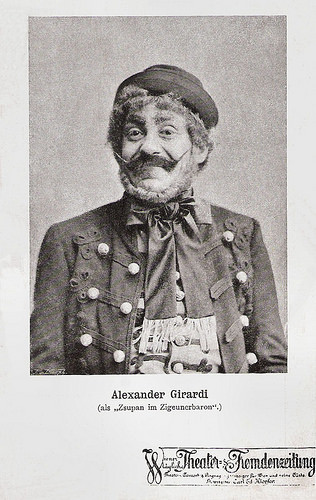
Austrian postcard by Carl Ed. Kopfer, Wien, presented with the Wiener Tägliche Theater- & Fremdenzeitung. Girardi as Kálmán Zsupán, a wealthy pig farmer of the Banat district, in the operetta Der Zigeunerbaron (The Gypsy Baron) by Johann Strauss. Girardi was a member of the cast of the original production which premiered at the Theater an der Wien on 24 October 1885.
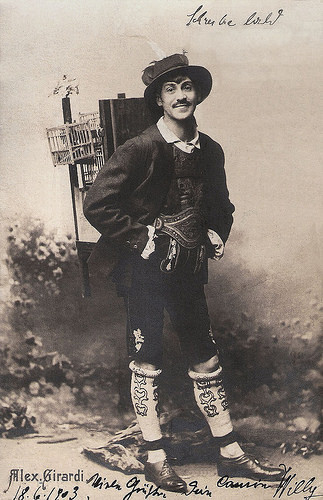
Austrian postcard by Julius Weisz, Wien, no. 123. Sent by mail in 1903. Girardi as the birdseller in the operetta Der Vogelhändler.
The Golden Age of the Vienna operetta
Alexander Girardi was born in Graz in 1850. His father was the locksmith Andreas Girardi who originated from Cortina d'Ampezzo. Following the early death of his father, Alexander was raised by his stepfather who put him into a locksmith apprenticeship.
Against his stepfather's wishes, he joined the amateur theatre Die Tonhalle, where his acting talent was discovered. This led to an engagement at the Vienna Strampfer-Theater.
In 1874 Girardi moved to the Theater an der Wien, where he continued to work for 22 years. In 1896-1897 he worked at the Carltheater and then two years at the Volkstheater in Vienna. He also had guest appearances at other important theatres in Vienna and toured Germany (Berlin, Hamburg, Dresden).
One of his most renowned roles was Valentin in Ferdinand Raimund's Der Verschwender (The Spendthrift). Particularly his rendition of the evergreen Das Hobellied, with music by Conradin Kreutzer, is famous in Austria. He worked in the tradition of Ferdinand Raimund and Johann Nestroy.
Girardi also contributed greatly to the Golden Age of the Vienna operetta. He created the roles of Blasoni in Johann Strauss's Cagliostro in Wien (Cagliostro in Vienna, 1875), Andredl in Karl Millöcker's Das verwunschene Schloss (The enchanted castle, 1878), Jan Janicki in Millöcker's Der Bettelstudent (The Beggar Student, 1882), Benozzo in Millöcker's Gasparone (1884), Kálmán Zsupán in Strauss's Der Zigeunerbaron (The Gypsy Baron, 1885), Adam in Carl Zeller's Der Vogelhändler (The Bird Seller, 1891), the title role in Edmund Eysler's Bruder Straubinger (Brother Straubinger, 1903), and Pali Rácz in Emmerich Kálmán’s Der Zigeunerprimas (The Gypsy Band Leader, 1912).
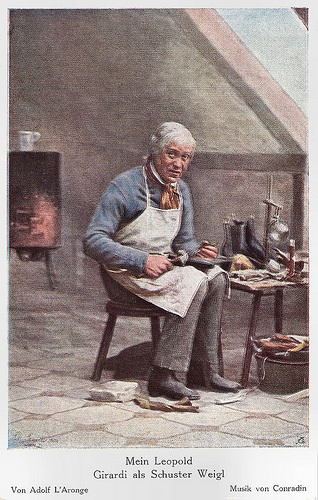
Austrian postcard by J. Gerstmayer, Wien, Serie X, no. 49. Girardi as Schuster Weigl in the stage operetta Mein Leopold (My Leopold) by Adolph L’Arronge. Music by Conradin. Caption: "Mein einzige Passion, Ist mein Leopold, mein Sohn." (My only Passion, Is my Leopold, my son.)

Austrian postcard by J. Gerstmayer, Wien. Photo: L. Gutmann. Girardi as Profoss in the stage operetta Heimliche Liebe (Secret Love, 1911) by Julius Bauer. Music by Paul Ottenheimer. Caption: "Küssen ist keine Sünd, mit einem schönen Kind, Lächt dir ein Rosenmund, Küss ihn zu jener Stund." (Kissing is not a sin, with a beautiful gal, If a rose mouth smiles to you, Kiss it that hour.)
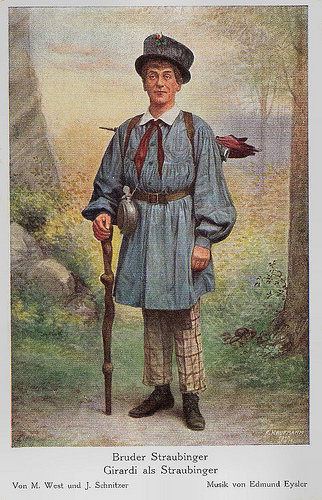
Austrian postcard by J. Gerstmayer, Wien. Photo: F. Kaufmann. Girardi as Straubinger in the stage operetta Bruder Straubinger (1903) by Moritz West and Ignaz Schnitzer. Music by Edmund Eysler.
Put into a mental asylum
Between 1893 till 1896, Alexander Girardi was unhappily married to actress Helene Odilon. Odilon had many affairs and had Girardi committed in a mental asylum based on a certificate by Julius Wagner-Jauregg, who had not even seen Girardi. The actress Katharina Schratt persuaded Emperor Franz Joseph to release Girardi.
Because of his huge popularity the cinema called and his film debut was Fiakerlied (1908). Another early silent film was Wann der Auerhahn balzt (1911). There was also a film version of Der Verschwender, Der Millionenonkel/The Spendthrift (Hubert Marischka, 1913).
At the beginning of World War I Alexander Girardi retired and returned to his birthplace Graz. Two months before his death in 1918, he was called to the Burgtheater in Vienna to play the role of Fortunatus Wurzel in Ferdinand Raimund's Der Bauer als Millionär (The Peasant as a Millionaire).
Aged 67, Alexander Girardi died in 1918 in Vienna. He is buried at the Vienna Zentralfriedhof. After his marriage to actress Helene Odilon, he was married to Eugenie Latinovics de Borsód from 1898 till his death.
Girardi's life was the subject of the film Der Komödiant von Wien/The Comedian of Vienna (Karl Paryla, Karl Stanzl, 1954) with Karl Paryla playing Girardi. The dish Girardirostbraten (Girardi roast beef) is named after him – a beef dish heavily covered with bacon and button mushrooms. His favourite hat style, a straw hat with flat crown and brim (a boater), became popular as the Girardi Hat. The city of Graz and the Vienna Mariahilf district have a Girardigasse (Girardi Lane) and there is a Girardipark in the district Innere Stadt. The Alexander Girardi International Singing Competition in Coburg is also named after him.
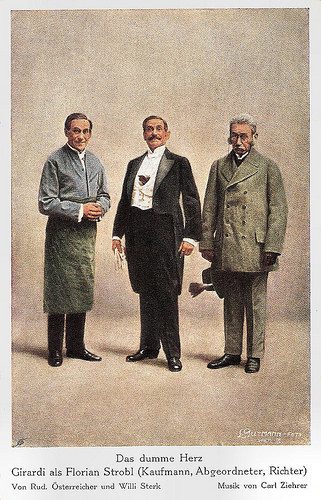
Austrian postcard by J. Gerstmayer, Wien, Serie VII, no. 33. Photo: L. Guttmann, Wien. Girardi as Florian Strobl in the stage operetta Das dumme Herz (The Stupid Heart, 1914) by Rudolf Österreicher and Will Sterk. Music by Carl Ziehrer. Caption: "Das Herz ist ein Uhrwerk, Das Stolz den Schöpfer preist, Es klingt in vollen Tönen, Wenn 'Lieb' der Zeiger weist." (The heart is a clockwork, which praises the Creator with pride, It sounds in full tones, When the pointer points 'love'.)
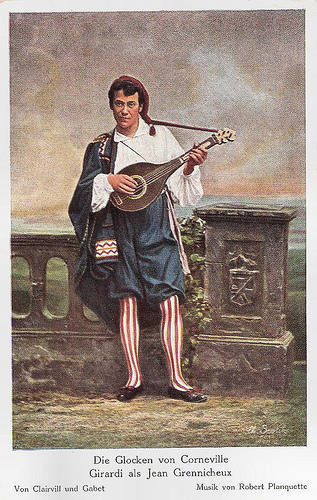
Austrian postcard by J. Gerstmayer, Wien. Photo: Charles Scolik, Wien. Girardi as Jean Grennicheux in the operetta Les Cloches de Corneville (1877) by Clairvill & Gabet. Music by Robert Planquette. Caption: "Fahr hin, Matrose, Wo Windesrose, Auf dem schaukelnden Meere, Dich treibt." (Go on, Sailor, Where the Wind, On the Rocking Sea, leads you.)
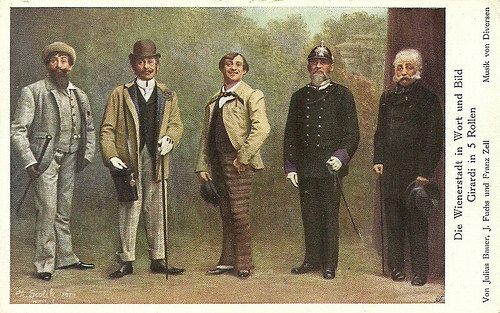
Austrian postcard. Die Wienerstadt in Wort und Bild. Girardi in 5 Rollen. Written by Julius Bauer, J. Fuchs and Franz Zell.
Sources: Wien Geschichte Wiki (German), The German Early Cinema Database (German), Wikipedia (German and English), and .

Austrian postcard by Carl Ed. Kopfer, Wien, presented with the Wiener Tägliche Theater- & Fremdenzeitung. Girardi as Kálmán Zsupán, a wealthy pig farmer of the Banat district, in the operetta Der Zigeunerbaron (The Gypsy Baron) by Johann Strauss. Girardi was a member of the cast of the original production which premiered at the Theater an der Wien on 24 October 1885.

Austrian postcard by Julius Weisz, Wien, no. 123. Sent by mail in 1903. Girardi as the birdseller in the operetta Der Vogelhändler.
The Golden Age of the Vienna operetta
Alexander Girardi was born in Graz in 1850. His father was the locksmith Andreas Girardi who originated from Cortina d'Ampezzo. Following the early death of his father, Alexander was raised by his stepfather who put him into a locksmith apprenticeship.
Against his stepfather's wishes, he joined the amateur theatre Die Tonhalle, where his acting talent was discovered. This led to an engagement at the Vienna Strampfer-Theater.
In 1874 Girardi moved to the Theater an der Wien, where he continued to work for 22 years. In 1896-1897 he worked at the Carltheater and then two years at the Volkstheater in Vienna. He also had guest appearances at other important theatres in Vienna and toured Germany (Berlin, Hamburg, Dresden).
One of his most renowned roles was Valentin in Ferdinand Raimund's Der Verschwender (The Spendthrift). Particularly his rendition of the evergreen Das Hobellied, with music by Conradin Kreutzer, is famous in Austria. He worked in the tradition of Ferdinand Raimund and Johann Nestroy.
Girardi also contributed greatly to the Golden Age of the Vienna operetta. He created the roles of Blasoni in Johann Strauss's Cagliostro in Wien (Cagliostro in Vienna, 1875), Andredl in Karl Millöcker's Das verwunschene Schloss (The enchanted castle, 1878), Jan Janicki in Millöcker's Der Bettelstudent (The Beggar Student, 1882), Benozzo in Millöcker's Gasparone (1884), Kálmán Zsupán in Strauss's Der Zigeunerbaron (The Gypsy Baron, 1885), Adam in Carl Zeller's Der Vogelhändler (The Bird Seller, 1891), the title role in Edmund Eysler's Bruder Straubinger (Brother Straubinger, 1903), and Pali Rácz in Emmerich Kálmán’s Der Zigeunerprimas (The Gypsy Band Leader, 1912).

Austrian postcard by J. Gerstmayer, Wien, Serie X, no. 49. Girardi as Schuster Weigl in the stage operetta Mein Leopold (My Leopold) by Adolph L’Arronge. Music by Conradin. Caption: "Mein einzige Passion, Ist mein Leopold, mein Sohn." (My only Passion, Is my Leopold, my son.)

Austrian postcard by J. Gerstmayer, Wien. Photo: L. Gutmann. Girardi as Profoss in the stage operetta Heimliche Liebe (Secret Love, 1911) by Julius Bauer. Music by Paul Ottenheimer. Caption: "Küssen ist keine Sünd, mit einem schönen Kind, Lächt dir ein Rosenmund, Küss ihn zu jener Stund." (Kissing is not a sin, with a beautiful gal, If a rose mouth smiles to you, Kiss it that hour.)

Austrian postcard by J. Gerstmayer, Wien. Photo: F. Kaufmann. Girardi as Straubinger in the stage operetta Bruder Straubinger (1903) by Moritz West and Ignaz Schnitzer. Music by Edmund Eysler.
Put into a mental asylum
Between 1893 till 1896, Alexander Girardi was unhappily married to actress Helene Odilon. Odilon had many affairs and had Girardi committed in a mental asylum based on a certificate by Julius Wagner-Jauregg, who had not even seen Girardi. The actress Katharina Schratt persuaded Emperor Franz Joseph to release Girardi.
Because of his huge popularity the cinema called and his film debut was Fiakerlied (1908). Another early silent film was Wann der Auerhahn balzt (1911). There was also a film version of Der Verschwender, Der Millionenonkel/The Spendthrift (Hubert Marischka, 1913).
At the beginning of World War I Alexander Girardi retired and returned to his birthplace Graz. Two months before his death in 1918, he was called to the Burgtheater in Vienna to play the role of Fortunatus Wurzel in Ferdinand Raimund's Der Bauer als Millionär (The Peasant as a Millionaire).
Aged 67, Alexander Girardi died in 1918 in Vienna. He is buried at the Vienna Zentralfriedhof. After his marriage to actress Helene Odilon, he was married to Eugenie Latinovics de Borsód from 1898 till his death.
Girardi's life was the subject of the film Der Komödiant von Wien/The Comedian of Vienna (Karl Paryla, Karl Stanzl, 1954) with Karl Paryla playing Girardi. The dish Girardirostbraten (Girardi roast beef) is named after him – a beef dish heavily covered with bacon and button mushrooms. His favourite hat style, a straw hat with flat crown and brim (a boater), became popular as the Girardi Hat. The city of Graz and the Vienna Mariahilf district have a Girardigasse (Girardi Lane) and there is a Girardipark in the district Innere Stadt. The Alexander Girardi International Singing Competition in Coburg is also named after him.

Austrian postcard by J. Gerstmayer, Wien, Serie VII, no. 33. Photo: L. Guttmann, Wien. Girardi as Florian Strobl in the stage operetta Das dumme Herz (The Stupid Heart, 1914) by Rudolf Österreicher and Will Sterk. Music by Carl Ziehrer. Caption: "Das Herz ist ein Uhrwerk, Das Stolz den Schöpfer preist, Es klingt in vollen Tönen, Wenn 'Lieb' der Zeiger weist." (The heart is a clockwork, which praises the Creator with pride, It sounds in full tones, When the pointer points 'love'.)

Austrian postcard by J. Gerstmayer, Wien. Photo: Charles Scolik, Wien. Girardi as Jean Grennicheux in the operetta Les Cloches de Corneville (1877) by Clairvill & Gabet. Music by Robert Planquette. Caption: "Fahr hin, Matrose, Wo Windesrose, Auf dem schaukelnden Meere, Dich treibt." (Go on, Sailor, Where the Wind, On the Rocking Sea, leads you.)

Austrian postcard. Die Wienerstadt in Wort und Bild. Girardi in 5 Rollen. Written by Julius Bauer, J. Fuchs and Franz Zell.
Sources: Wien Geschichte Wiki (German), The German Early Cinema Database (German), Wikipedia (German and English), and .
Published on July 10, 2017 22:00
Elsa Martinelli (1935-2017)
On 8 July 2017, glamorous Italian actress and former fashion model Elsa Martinelli (1935) has died. She showed her beautiful curves in many European and Hollywood productions of the 1950s and 1960s, but somehow she never became the star she was destined to become in the mid-1950s. Martinelli was 82.
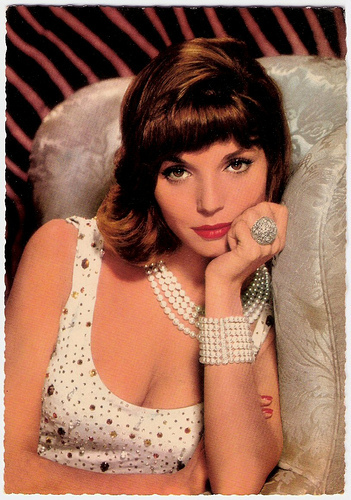
German postcard by Krüger, no. 902/255.
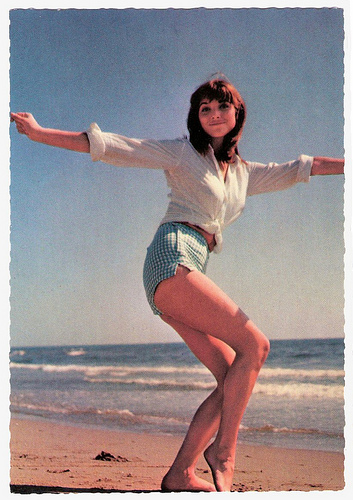
German postcard by ISV, no. D 22. Photo: Pierluigi.
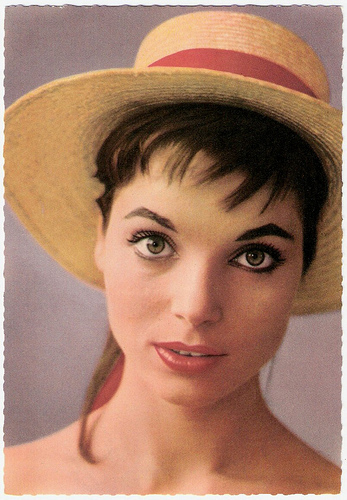
German postcard by ISV, no. D 27. Photo: Pierluigi.
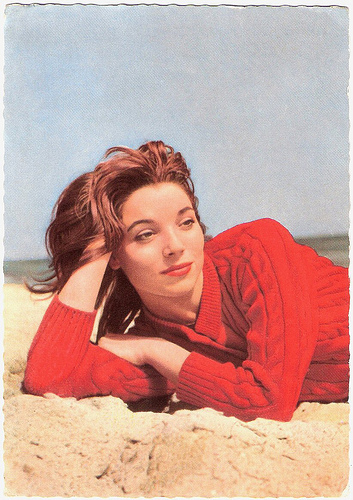
German postcard by Universum-Film Aktiengesellschaft (Ufa), Berlin-Tempelhof, no. CK 39. Retail price: 30 Pfg. Photo: Ufa.
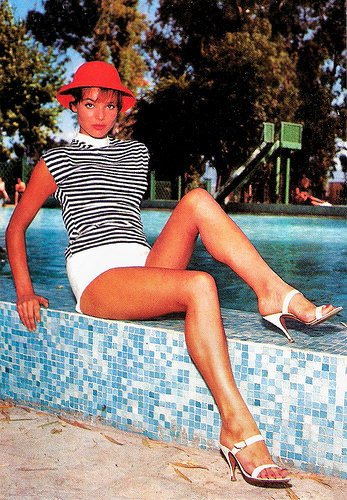
Spanish postcard by Postal Oscarcolor, no. 407.
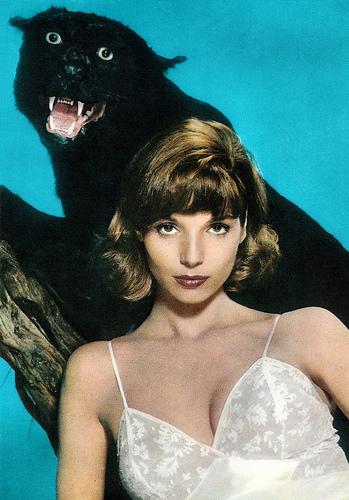
Italian postcard by Rotalcolor, Milano, no. N. 178. Photo: Warner Bros. Publicity still for Hatari! (Howard Hawks, 1962).
The World of Fashion
Elsa Martinelli was born Elsa Tia in Grosseto, Tuscany, in 1935. Soon after her birth, her large and very poor family moved to Rome. Elsa had to earn her keep from the age of twelve, delivering groceries.
In 1953, while working as a barmaid, she was discovered by designer Roberto Capucci who introduced her to the fashion world. She became a model and began playing small roles in films.
She appeared uncredited in Le Rouge et le noir/Scarlet and Black (Claude Autant-Lara, 1954) starring Gérard Philipe.
Her first important film role came the following year with the American Western The Indian Fighter (André De Toth, 1955), in which she played the Native American heroine opposite Kirk Douglas. Douglas claims to have spotted her on a Life magazine cover and hired her for his production company, Bryna Productions.
She returned to Rome and starred in the Carlo Ponti production La risaia/Rice Girl (Raffaello Matarazzo, 1956) with Folco Lulli and Rik Battaglia . The melodrama was an obvious attempt to recapture the success of Riso Amaro/Bitter Rice (Giuseppe De Santis, 1949) with Silvana Mangano as the sexy rice field worker in hot pants. The attempt worked quite well.

Italian postcard by Rotalfoto, Milano / G.B. & F., V, no. 2072. Photo: Carlo Ponti. Publicity still for La risaia/Rice Girl (Raffaello Matarazzo, 1956). Caption: Saluti dalla Risaia (Greetings from the rice girl).
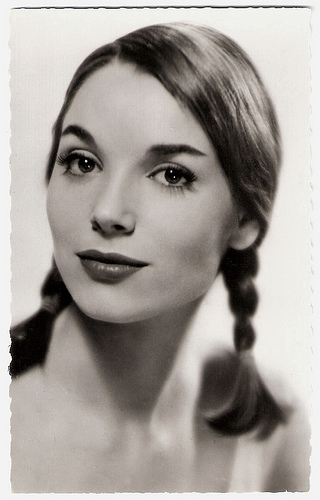
French postcard by Editions P.I., Paris, offered by Les Carbones Korès 'Carboplane', no. 917. Photo: Paramount, 1957.
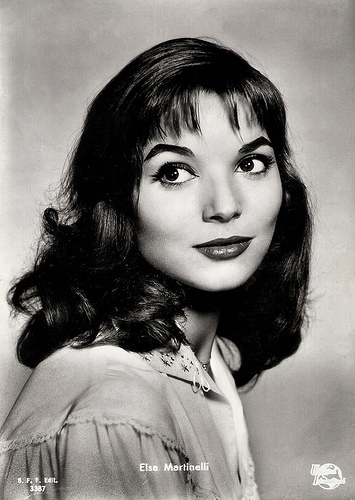
Italian postcard by Casa Editr. Ballerini & Fratini, Firenze (B.F.F. Edit.), no. 3387. Photo: Universal.
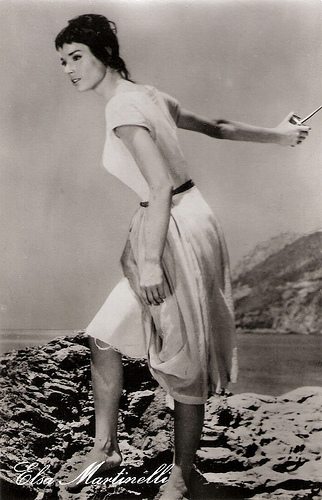
East-German postcard by VEB Progress Film-Vertrieb, no. 1064, 1959. Retail price: 0,20 DM. Photo: Maxima-Lux Rome; Aspa, Madrid. Publicity still for La mina/The Mine (Giuseppe Bennati, 1957).
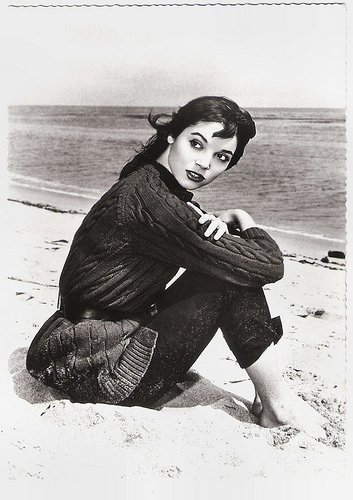
Italian postcard by 3K, no. 3841.
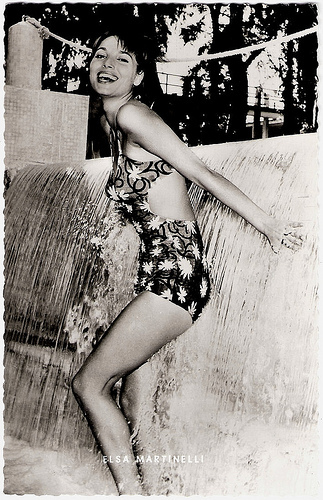
German postcard by Kunst und Bild, Berlin-Charlottenburg, no. S 737. Photo: Unitalia-Film / Dial.
Modern Cinderella
In 1956 Elsa Martinelli won the Silver Berlin Bear for Best Actress at the Berlin International Film Festival. She won this prestigious award for playing a modern Cinderella in the comedy Donatella (Mario Monicelli, 1956) with Gabriele Ferzetti .
From then on, she divided her time between Europe and the US and appeared in such films as Four Girls in Town (Jack Sher, 1956) with George Nader , Manuela/The Stowaway Girl (Guy Hamilton, 1957) with Trevor Howard , the historical drama I Battellieri del Volga/Prisoner of the Volga (Victor Tourjansky, 1959) with John Derek and the romance Un amore a Roma/Love in Rome (Dino Risi, 1960).
Highlights were the excellent drama La notte brava (Mauro Bolognini, 1959), based on a novel by Pier Paolo Pasolini and the haunting and surreal horror film Et mourir de plaisir/Blood and Roses (Roger Vadim, 1960).
The latter was an attempt to retell the classic Sheridan Le Fanu vampire tale Carmilla, co-starring the director's wife Annette Vadim (or Annette Stroyberg).
In 1957 Elsa married wealthy Count Franco Mancinelli Scotti di San Vito. Her mother-in-law, Countess Margherita Manicineli Scotti di San Vito, reportedly expelled her son from their Rome palace because the marriage was against her wishes. Finally she fired her son from his job as manager of the family estate.
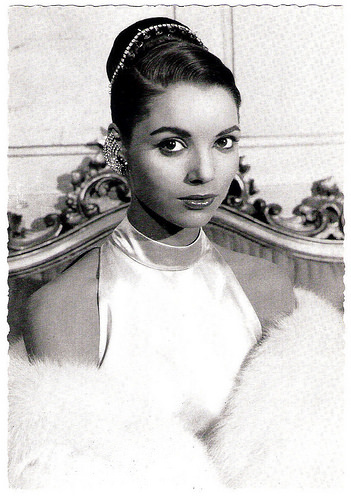
German postcard by Filmbilder-Vertrieb Ernst Freihoff, Essen, no. 233. Photo: Georg Michalke.
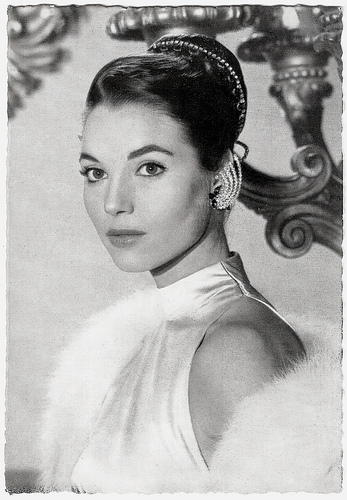
German postcard by WS-Druck, Wanne-Eickel, no. 284. Photo: Georg Michalke / Archiv Filmpress Zürich.
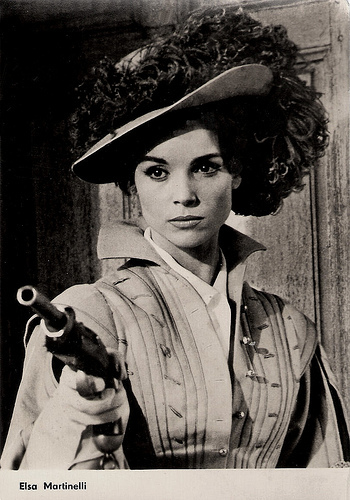
East-German postcard by VEB Progress Film-Vertrieb, Berlin, no. 1.974, 1963. Photo: publicity still for Le capitan/Captain Blood (André Hunebelle, 1960).
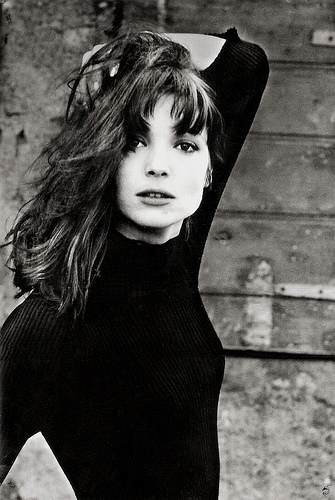
Romanian postcard by Casa Filmului Acin, no. 103. Photo: publicity still for Hatari! (Howard Hawks, 1962).

Romanian postcard by Casa Filmului Acin, no. 470. Sent by mail in 1972. Photo: publicity still for Le procès/The Trial (Orson Welles, 1962) with Anthony Perkins .
Tried and True Howard Hawks Fashion
One of Elsa Martinelli’s most interesting films is Orson Welles ’ adaptation of Franz Kafka's The Trial, Le Procès (Orson Welles, 1962). Anthony Perkins played Joseph K, a man condemned for an unnamed crime in an unnamed country. Seeking justice, he is sucked into a labyrinth of bureaucracy. Along the way, he becomes involved with three women - Jeanne Moreau , Romy Schneider and Martinelli - who in their own individual ways are functions of the System that persecutes him.
In the action and adventure comedy Hatari! (Howard Hawks, 1962) she played a freelance wildlife photographer on a Tanganyika game farm. Martinelli was the eye candy in a star cast with John Wayne, Gérard Blain, Red Buttons and Hardy Krüger . Hal Erickson at AllMovie : "Wayne's men-only contingent is reduced to jello when Elsa enters the scene, but in tried and true Howard Hawks fashion, she quickly becomes ‘one of the guys’."
In the comedy The Pigeon That Took Rome (Melville Shavelson, 1962) she starred opposite Charlton Heston, and in The V.I.P.’s (Anthony Asquith, 1963) she was the protegee of Orson Welles .
In the South Seas adventure Rampage (Phil Karlson, 1963) she co-starred with Robert Mitchum , and in the episodic sex comedy Sette Volte Donna/Woman Times Seven (Vittorio De Sica, 1967) with Lex Barker .
In the big-budget adaptation of Terry Southern's satiric sex farce Candy (Christian Marquand, 1968), she played Candy’s mother in a cast with Charles Aznavour , Marlon Brando , and Richard Burton .
In Italy she made the near surrealist western Il mio corpo per un poker/Belle Starr (Piero Cristofani, Lina Wertmuller, 1968), and a stylish erotic thriller, Una sull'altra/One on Top of the Other (Lucio Fulci, 1969), with Marisa Mell and Jean Sorel .
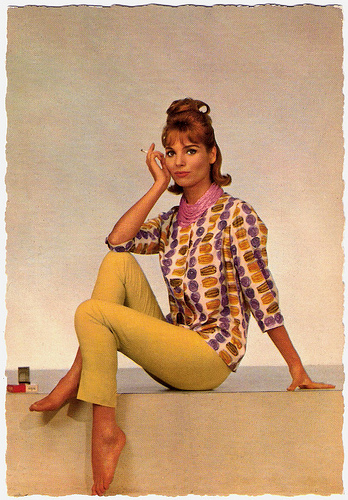
French postcard by E.D.U.G., no. 199. Photo: Sam Lévin.
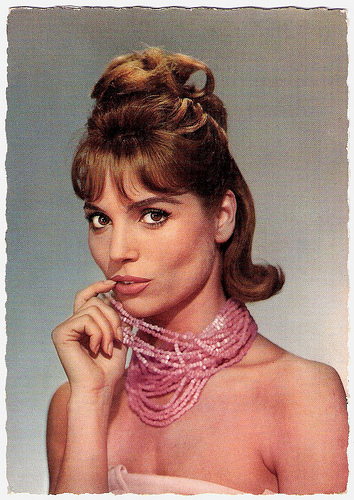
French postcard by E.D.U.G., no. 124. Photo: Sam Lévin.
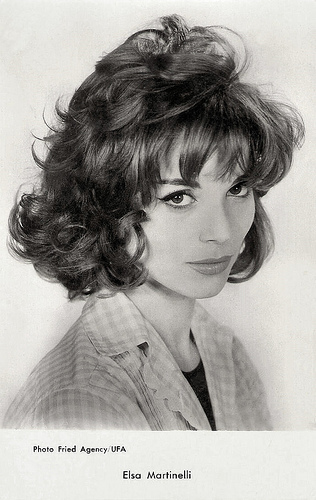
French postcard by Editions P.I., Paris, offered by Les Carbones Korès 'Carboplane', no. FK 32. Photo: Fried Agency / Ufa.
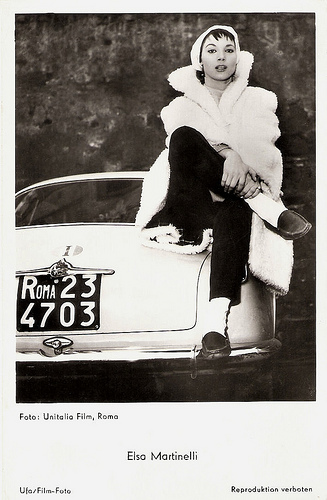
German postcard by Ufa/Film-Foto, no. FK 3172. Photo: Unitalia Film, Roma.
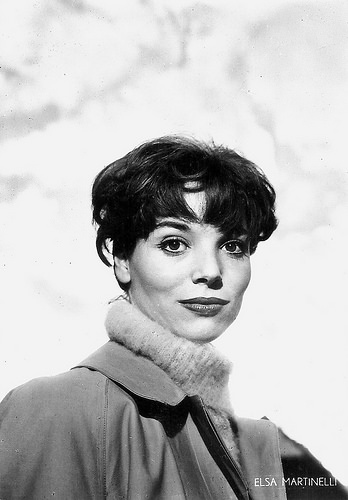
Italian photocard, editor and photographer unknown.
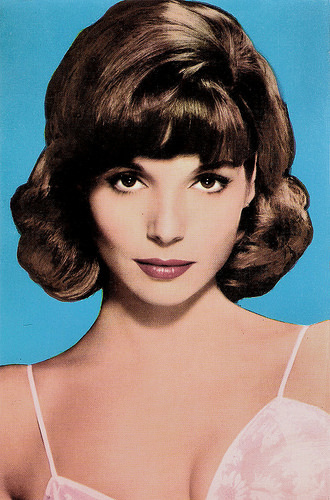
Spanish postcard by Archivo Bermejo, no. C. 263, 1965. Photo: Warner Bros. Publicity still for Hatari! (Howard Hawks, 1962).
Interior Designer
In the 1970s the film career of Elsa Martinelli somehow halted. She only appeared incidentally in European films. She starred opposite Robert Hossein in the French caper film La Part des Lions/The Lions' Share (Jean Larriaga, 1971), and she played a supporting part in the political drama Garofano Rosso/The Red Carnation (Luigi Faccini, 1976) with Marina Berti .
On TV she appeared as a guest star in The Return of the Saint (1979) with Ian Ogilvy as Simon Templar. Meanwhile she had started a new, successful career as an interior designer, but she continued to accept incidental parts in films and TV-series.
After Sono Un Fenomeno Paranormale/I'm a Paranormal Phenomenon (Sergio Corbucci, 1985) with Alberto Sordi , she made unheralded return appearances in the international productions Arrivederci Roma (Clive Donner, 1990) and the inconsequential all-star comedy Once Upon a Crime (Eugene Levy, 1992).
Most recently she was seen in the short film Cabiria, Priscilla e le altre/Cabiria, Priscilla and the Others (Fabrizio Celestini, 1999) and the TV-series Orgoglio (2005).
Elsa Martinelli was married from 1957 till 1964 to Count Franco Mancinelli Scotti di San Vito, by whom she has a daughter, actress Cristiana Mancinelli (1958). In 1968 she married Paris Match photographer and 1970s furniture designer Willy Rizzo, with whom she had a son.
On 8 July 2017, Elsa Martinelli passed away in Rome, Italy. She was 82. Her husband Willy Rizzo had died in 2013.
Trailer The Indian Fighter (1955). Source: zinho jp (YouTube).
Italian trailer Donatella (1956). Source: CG Entertainment (YouTube). No subtitles, sorry.
German DVD trailer for La risaia/Rice Girl 1956).Source: Arild Rafalzik (YouTube). No subtitles, sorry.
Trailer Hatari! (1962). Source: Paramountmovies Digital (YouTube).
Trailer Le Procès/The Trial (1962). Source: Danios 12345 (YouTube).
Elsa Martinelli and Robert Hoffman in Come Imparai ad Amare le Donne (1967). Source: stranevisioni (YouTube). No subtitles, sorry.
Sources: Hal Erickson (AllMovie), Marlène Pilaete (Les Gens du Cinéma - French), Kimberly Lindbergs (Cinebeats), Gerald A. DeLuca (IMDb), Glamour Girls of the Silver Screen, Wikipedia, and .

German postcard by Krüger, no. 902/255.

German postcard by ISV, no. D 22. Photo: Pierluigi.

German postcard by ISV, no. D 27. Photo: Pierluigi.

German postcard by Universum-Film Aktiengesellschaft (Ufa), Berlin-Tempelhof, no. CK 39. Retail price: 30 Pfg. Photo: Ufa.

Spanish postcard by Postal Oscarcolor, no. 407.

Italian postcard by Rotalcolor, Milano, no. N. 178. Photo: Warner Bros. Publicity still for Hatari! (Howard Hawks, 1962).
The World of Fashion
Elsa Martinelli was born Elsa Tia in Grosseto, Tuscany, in 1935. Soon after her birth, her large and very poor family moved to Rome. Elsa had to earn her keep from the age of twelve, delivering groceries.
In 1953, while working as a barmaid, she was discovered by designer Roberto Capucci who introduced her to the fashion world. She became a model and began playing small roles in films.
She appeared uncredited in Le Rouge et le noir/Scarlet and Black (Claude Autant-Lara, 1954) starring Gérard Philipe.
Her first important film role came the following year with the American Western The Indian Fighter (André De Toth, 1955), in which she played the Native American heroine opposite Kirk Douglas. Douglas claims to have spotted her on a Life magazine cover and hired her for his production company, Bryna Productions.
She returned to Rome and starred in the Carlo Ponti production La risaia/Rice Girl (Raffaello Matarazzo, 1956) with Folco Lulli and Rik Battaglia . The melodrama was an obvious attempt to recapture the success of Riso Amaro/Bitter Rice (Giuseppe De Santis, 1949) with Silvana Mangano as the sexy rice field worker in hot pants. The attempt worked quite well.

Italian postcard by Rotalfoto, Milano / G.B. & F., V, no. 2072. Photo: Carlo Ponti. Publicity still for La risaia/Rice Girl (Raffaello Matarazzo, 1956). Caption: Saluti dalla Risaia (Greetings from the rice girl).

French postcard by Editions P.I., Paris, offered by Les Carbones Korès 'Carboplane', no. 917. Photo: Paramount, 1957.

Italian postcard by Casa Editr. Ballerini & Fratini, Firenze (B.F.F. Edit.), no. 3387. Photo: Universal.

East-German postcard by VEB Progress Film-Vertrieb, no. 1064, 1959. Retail price: 0,20 DM. Photo: Maxima-Lux Rome; Aspa, Madrid. Publicity still for La mina/The Mine (Giuseppe Bennati, 1957).

Italian postcard by 3K, no. 3841.

German postcard by Kunst und Bild, Berlin-Charlottenburg, no. S 737. Photo: Unitalia-Film / Dial.
Modern Cinderella
In 1956 Elsa Martinelli won the Silver Berlin Bear for Best Actress at the Berlin International Film Festival. She won this prestigious award for playing a modern Cinderella in the comedy Donatella (Mario Monicelli, 1956) with Gabriele Ferzetti .
From then on, she divided her time between Europe and the US and appeared in such films as Four Girls in Town (Jack Sher, 1956) with George Nader , Manuela/The Stowaway Girl (Guy Hamilton, 1957) with Trevor Howard , the historical drama I Battellieri del Volga/Prisoner of the Volga (Victor Tourjansky, 1959) with John Derek and the romance Un amore a Roma/Love in Rome (Dino Risi, 1960).
Highlights were the excellent drama La notte brava (Mauro Bolognini, 1959), based on a novel by Pier Paolo Pasolini and the haunting and surreal horror film Et mourir de plaisir/Blood and Roses (Roger Vadim, 1960).
The latter was an attempt to retell the classic Sheridan Le Fanu vampire tale Carmilla, co-starring the director's wife Annette Vadim (or Annette Stroyberg).
In 1957 Elsa married wealthy Count Franco Mancinelli Scotti di San Vito. Her mother-in-law, Countess Margherita Manicineli Scotti di San Vito, reportedly expelled her son from their Rome palace because the marriage was against her wishes. Finally she fired her son from his job as manager of the family estate.

German postcard by Filmbilder-Vertrieb Ernst Freihoff, Essen, no. 233. Photo: Georg Michalke.

German postcard by WS-Druck, Wanne-Eickel, no. 284. Photo: Georg Michalke / Archiv Filmpress Zürich.

East-German postcard by VEB Progress Film-Vertrieb, Berlin, no. 1.974, 1963. Photo: publicity still for Le capitan/Captain Blood (André Hunebelle, 1960).

Romanian postcard by Casa Filmului Acin, no. 103. Photo: publicity still for Hatari! (Howard Hawks, 1962).

Romanian postcard by Casa Filmului Acin, no. 470. Sent by mail in 1972. Photo: publicity still for Le procès/The Trial (Orson Welles, 1962) with Anthony Perkins .
Tried and True Howard Hawks Fashion
One of Elsa Martinelli’s most interesting films is Orson Welles ’ adaptation of Franz Kafka's The Trial, Le Procès (Orson Welles, 1962). Anthony Perkins played Joseph K, a man condemned for an unnamed crime in an unnamed country. Seeking justice, he is sucked into a labyrinth of bureaucracy. Along the way, he becomes involved with three women - Jeanne Moreau , Romy Schneider and Martinelli - who in their own individual ways are functions of the System that persecutes him.
In the action and adventure comedy Hatari! (Howard Hawks, 1962) she played a freelance wildlife photographer on a Tanganyika game farm. Martinelli was the eye candy in a star cast with John Wayne, Gérard Blain, Red Buttons and Hardy Krüger . Hal Erickson at AllMovie : "Wayne's men-only contingent is reduced to jello when Elsa enters the scene, but in tried and true Howard Hawks fashion, she quickly becomes ‘one of the guys’."
In the comedy The Pigeon That Took Rome (Melville Shavelson, 1962) she starred opposite Charlton Heston, and in The V.I.P.’s (Anthony Asquith, 1963) she was the protegee of Orson Welles .
In the South Seas adventure Rampage (Phil Karlson, 1963) she co-starred with Robert Mitchum , and in the episodic sex comedy Sette Volte Donna/Woman Times Seven (Vittorio De Sica, 1967) with Lex Barker .
In the big-budget adaptation of Terry Southern's satiric sex farce Candy (Christian Marquand, 1968), she played Candy’s mother in a cast with Charles Aznavour , Marlon Brando , and Richard Burton .
In Italy she made the near surrealist western Il mio corpo per un poker/Belle Starr (Piero Cristofani, Lina Wertmuller, 1968), and a stylish erotic thriller, Una sull'altra/One on Top of the Other (Lucio Fulci, 1969), with Marisa Mell and Jean Sorel .

French postcard by E.D.U.G., no. 199. Photo: Sam Lévin.

French postcard by E.D.U.G., no. 124. Photo: Sam Lévin.

French postcard by Editions P.I., Paris, offered by Les Carbones Korès 'Carboplane', no. FK 32. Photo: Fried Agency / Ufa.

German postcard by Ufa/Film-Foto, no. FK 3172. Photo: Unitalia Film, Roma.

Italian photocard, editor and photographer unknown.

Spanish postcard by Archivo Bermejo, no. C. 263, 1965. Photo: Warner Bros. Publicity still for Hatari! (Howard Hawks, 1962).
Interior Designer
In the 1970s the film career of Elsa Martinelli somehow halted. She only appeared incidentally in European films. She starred opposite Robert Hossein in the French caper film La Part des Lions/The Lions' Share (Jean Larriaga, 1971), and she played a supporting part in the political drama Garofano Rosso/The Red Carnation (Luigi Faccini, 1976) with Marina Berti .
On TV she appeared as a guest star in The Return of the Saint (1979) with Ian Ogilvy as Simon Templar. Meanwhile she had started a new, successful career as an interior designer, but she continued to accept incidental parts in films and TV-series.
After Sono Un Fenomeno Paranormale/I'm a Paranormal Phenomenon (Sergio Corbucci, 1985) with Alberto Sordi , she made unheralded return appearances in the international productions Arrivederci Roma (Clive Donner, 1990) and the inconsequential all-star comedy Once Upon a Crime (Eugene Levy, 1992).
Most recently she was seen in the short film Cabiria, Priscilla e le altre/Cabiria, Priscilla and the Others (Fabrizio Celestini, 1999) and the TV-series Orgoglio (2005).
Elsa Martinelli was married from 1957 till 1964 to Count Franco Mancinelli Scotti di San Vito, by whom she has a daughter, actress Cristiana Mancinelli (1958). In 1968 she married Paris Match photographer and 1970s furniture designer Willy Rizzo, with whom she had a son.
On 8 July 2017, Elsa Martinelli passed away in Rome, Italy. She was 82. Her husband Willy Rizzo had died in 2013.
Trailer The Indian Fighter (1955). Source: zinho jp (YouTube).
Italian trailer Donatella (1956). Source: CG Entertainment (YouTube). No subtitles, sorry.
German DVD trailer for La risaia/Rice Girl 1956).Source: Arild Rafalzik (YouTube). No subtitles, sorry.
Trailer Hatari! (1962). Source: Paramountmovies Digital (YouTube).
Trailer Le Procès/The Trial (1962). Source: Danios 12345 (YouTube).
Elsa Martinelli and Robert Hoffman in Come Imparai ad Amare le Donne (1967). Source: stranevisioni (YouTube). No subtitles, sorry.
Sources: Hal Erickson (AllMovie), Marlène Pilaete (Les Gens du Cinéma - French), Kimberly Lindbergs (Cinebeats), Gerald A. DeLuca (IMDb), Glamour Girls of the Silver Screen, Wikipedia, and .
Published on July 10, 2017 22:00
July 9, 2017
Anneliese Uhlig (1918-2017)
On 17 June 2017, German actress Anneliese Uhlig passed away at the age of 98. She was an elegant and enchanting femme fatale of Ufa crime films of the 1940s. The classic beauty unwillingly bewitched Joseph Goebbels. After the war she also worked internationally as a journalist, theatre producer and university teacher. She became an American citizen and died in Santa Cruz in California.
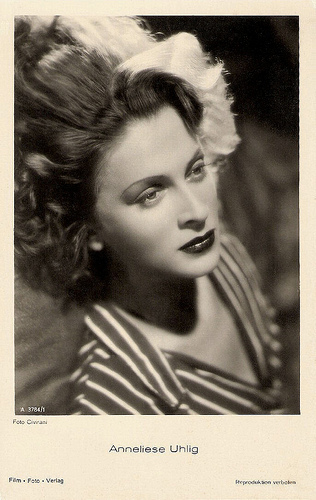
German Postcard by Film-Foto-Verlag, no. A 3784/1, 1941-1944. Photo: Civirani.
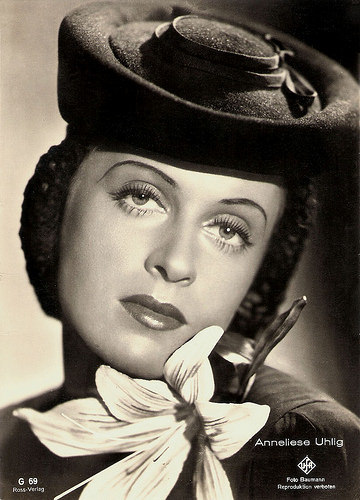
German postcard by Ross Verlag, no. G 69. Photo: Ufa / Baumann.
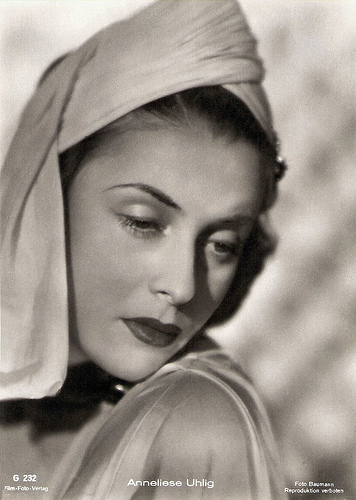
German postcard by Film-Foto-Verlag, no. G 232. Photo: Baumann.
Crime Films
Anneliese Uhlig was born in 1918 in Essen, Germany into an artistic family. Her mother was the opera singer Margarethe Maschmann, her father the stage actor Kurt Uhlig. After the divorce of her parents, she lived with her mother in Dortmund, Leipzig and Braunschweig.
After acting lessons at the Peter-Reimann-Akademie in Berlin, the 19-years-old Uhlig was discovered by Thea von Harbou, the second wife of director Fritz Lang. Uhlig made her film debut with Manege (Carmine Gallone, 1937), followed by Stimme des Blutes/The Voice of Blood (Carmine Gallone, 1937), both starring Attila Hörbiger and Lucie Höflich.
In 1938 she made her stage debut at the Schillertheater in Berlin in a successful production of Der Richter von Zalamea (El alcalde de Zalamea/The Judge of Alamea) by Pedro Calderón de la Barca. At the side of Heinrich George she made a European tour with this production.
The beautiful actress soon became a popular leading lady in crime films like Der Vorhang fällt/The Curtain Falls (Georg Jacoby, 1939), Kriminalkommissar Eyck/Detective superintendent Eyck (Milo Harbich, 1939) co-starring with Paul Klinger , and Golowin geht durch die Stadt/Golowin Goes Through Town (Robert A. Stemmle, 1940).
Next she played a nurse between two lieutenants in the propaganda film Blutsbrüderschaft/Blood Brotherhood (Philipp Lothar Mayring, 1940). She also performed for the German troops in Holland, France, Poland and Russia.
In 1942 she had a conflict with propaganda minister Joseph Goebbels . Reportedly she said 'no' to his avances and he replied: "This way you won't have a career". And she was dismissed by the German studios.
Her friend Maria Cebotari invited her to come to Italy where she took part in five films, including Don Cesare di Bazan/Don Cesar of Bazan (Riccardo Freda, 1942) with Gino Cervi, and La Fornarina (Enrico Guazzoni, 1944) with Lida Baarová .
She was ordered to return to Germany in 1943 to perform for the troops. She continued her film career with Der Majoratsherr/The Heir (Hans Deppe, 1944) with Willy Birgel , and the marriage drama Solistin Anna Alt/Soloist Anna Alt (Werner Klingler, 1945). She also worked as a translator for Mussolini family. when they stayed at a Bavarian castle.
The romantic comedy Das Mädchen Juanita/The Girl Juanita (Wolfgang Staudte, 1945) could not be finished in 1945 because of the end of World War II. Later, it was edited with material from the archives and released in West Germany in 1952.
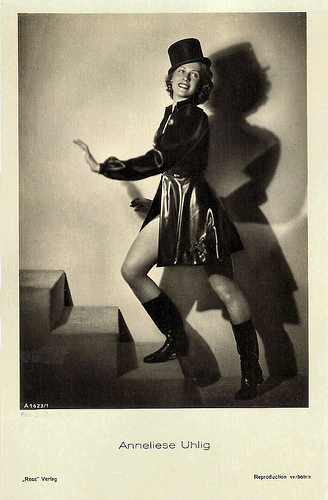
German postcard by Ross Verlag, no. A 1623/1, 1937-1938. Photo: Sandau.
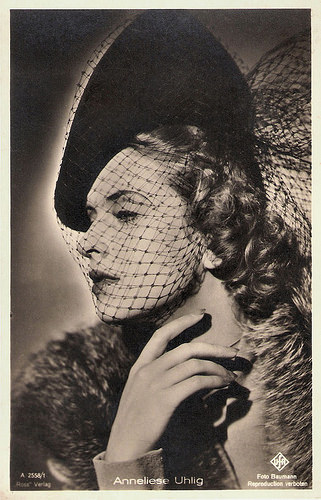
German postcard by Ross Verlag, no. A 2558/1, 1939-1940. Photo: Ufa / Baumann.
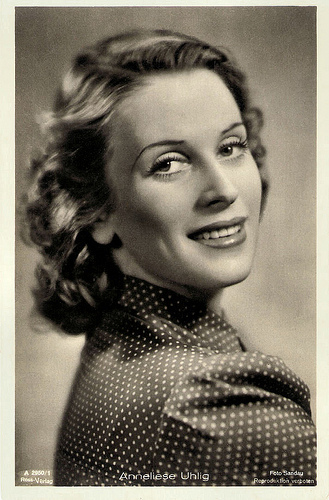
German postcard by Ross Verlag, no. A 2950/1, 1939-1940. Photo: Sandau.
American Nationality
After the war Anneliese Uhlig married American lieutenant and art historian Douglas B. Tucker and worked as a director and producer for the US Special Service in Salzburg.
From 1946 to 1967 she was a foreign correspondent in Italy, Austria and the USA. She also wrote political articles for different German and American newspapers. In 1948 she moved to the USA where she later got the American nationality.
In the 1950s she appeared again in German films like Solange Du da bist/As Long As You Are There (Harald Braun, 1953) starring Maria Schell and O.W. Fischer , and Dany, bitte schreiben Sie/Dany, Please Write (Eduard von Borsody, 1956) featuring Sonja Ziemann .
After that she took another break from the cinema and worked as a newspaper editor and theatre producer in Alexandria, Virginia, and from 1963 till 1965 as a university teacher German and Drama in Bangkok, Thailand.
She continued her acting career in Germany in the 1970s and appeared on stage and TV. To her TV films belong the Wilkie Collins adaptation Der Monddiamant/The Moonstone (Wilhelm Semmelroth, 1974) with Paul Dahlke and Theo Lingen , Es gibt noch Haselnusssträucher/Hazels (Vojtech Jasny, 1983) with Heinz Rühmann and Katharina Böhm, and Coming Home (Giles Foster, 1998) with Peter O’Toole and Joanna Lumley.
Anneliese Uhlig had a son, Peter, from her first marriage to actor Kurt Waitzmann. Her second husband Douglas B. Tucker had passed away in 2009 and her son Peter in 2013. They lived in Santa Cruz, California, where Anneliese Uhlig died on 17 June 2017.
Annelies Uhlig published a few books, including the autobiography Rosenkavaliers Kind: Eine Frau und drei Karrieren (The Child of the Rosenkavalier - one woman and three careers). Rosemarie Killius in Frankfurter Allgemeine: "A readable work of contemporary history which surpasses anything else one can find of actor biographies on the market."
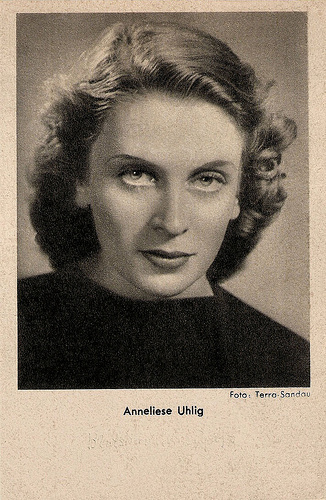
German postcard by Das Programm von Heute, Zeitschrift für Film und Theater G.m.b.H., Berlin. Licensed by Ross Verlag, Berlin. Photo: Terra / Sandau.
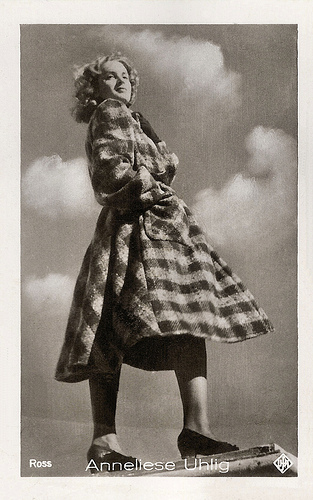
Small German card by Ross. Photo: Ufa.
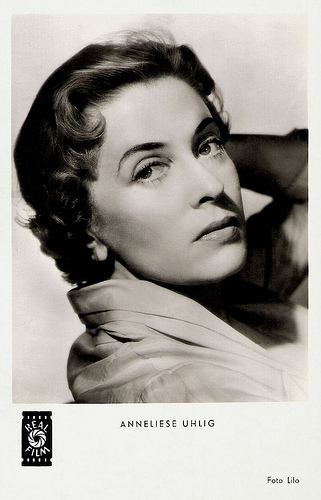
German postcard by Kunst und Bild, no. T 655. Photo: Lilo.
Sources: Rosemarie Killius (Frankfurter Allgemeine - German), Stephanie D'heil (Steffie-Line - German), Thomas Staedeli (Cyranos), Wikipedia (German), Filmportal.de (German) and .

German Postcard by Film-Foto-Verlag, no. A 3784/1, 1941-1944. Photo: Civirani.

German postcard by Ross Verlag, no. G 69. Photo: Ufa / Baumann.

German postcard by Film-Foto-Verlag, no. G 232. Photo: Baumann.
Crime Films
Anneliese Uhlig was born in 1918 in Essen, Germany into an artistic family. Her mother was the opera singer Margarethe Maschmann, her father the stage actor Kurt Uhlig. After the divorce of her parents, she lived with her mother in Dortmund, Leipzig and Braunschweig.
After acting lessons at the Peter-Reimann-Akademie in Berlin, the 19-years-old Uhlig was discovered by Thea von Harbou, the second wife of director Fritz Lang. Uhlig made her film debut with Manege (Carmine Gallone, 1937), followed by Stimme des Blutes/The Voice of Blood (Carmine Gallone, 1937), both starring Attila Hörbiger and Lucie Höflich.
In 1938 she made her stage debut at the Schillertheater in Berlin in a successful production of Der Richter von Zalamea (El alcalde de Zalamea/The Judge of Alamea) by Pedro Calderón de la Barca. At the side of Heinrich George she made a European tour with this production.
The beautiful actress soon became a popular leading lady in crime films like Der Vorhang fällt/The Curtain Falls (Georg Jacoby, 1939), Kriminalkommissar Eyck/Detective superintendent Eyck (Milo Harbich, 1939) co-starring with Paul Klinger , and Golowin geht durch die Stadt/Golowin Goes Through Town (Robert A. Stemmle, 1940).
Next she played a nurse between two lieutenants in the propaganda film Blutsbrüderschaft/Blood Brotherhood (Philipp Lothar Mayring, 1940). She also performed for the German troops in Holland, France, Poland and Russia.
In 1942 she had a conflict with propaganda minister Joseph Goebbels . Reportedly she said 'no' to his avances and he replied: "This way you won't have a career". And she was dismissed by the German studios.
Her friend Maria Cebotari invited her to come to Italy where she took part in five films, including Don Cesare di Bazan/Don Cesar of Bazan (Riccardo Freda, 1942) with Gino Cervi, and La Fornarina (Enrico Guazzoni, 1944) with Lida Baarová .
She was ordered to return to Germany in 1943 to perform for the troops. She continued her film career with Der Majoratsherr/The Heir (Hans Deppe, 1944) with Willy Birgel , and the marriage drama Solistin Anna Alt/Soloist Anna Alt (Werner Klingler, 1945). She also worked as a translator for Mussolini family. when they stayed at a Bavarian castle.
The romantic comedy Das Mädchen Juanita/The Girl Juanita (Wolfgang Staudte, 1945) could not be finished in 1945 because of the end of World War II. Later, it was edited with material from the archives and released in West Germany in 1952.

German postcard by Ross Verlag, no. A 1623/1, 1937-1938. Photo: Sandau.

German postcard by Ross Verlag, no. A 2558/1, 1939-1940. Photo: Ufa / Baumann.

German postcard by Ross Verlag, no. A 2950/1, 1939-1940. Photo: Sandau.
American Nationality
After the war Anneliese Uhlig married American lieutenant and art historian Douglas B. Tucker and worked as a director and producer for the US Special Service in Salzburg.
From 1946 to 1967 she was a foreign correspondent in Italy, Austria and the USA. She also wrote political articles for different German and American newspapers. In 1948 she moved to the USA where she later got the American nationality.
In the 1950s she appeared again in German films like Solange Du da bist/As Long As You Are There (Harald Braun, 1953) starring Maria Schell and O.W. Fischer , and Dany, bitte schreiben Sie/Dany, Please Write (Eduard von Borsody, 1956) featuring Sonja Ziemann .
After that she took another break from the cinema and worked as a newspaper editor and theatre producer in Alexandria, Virginia, and from 1963 till 1965 as a university teacher German and Drama in Bangkok, Thailand.
She continued her acting career in Germany in the 1970s and appeared on stage and TV. To her TV films belong the Wilkie Collins adaptation Der Monddiamant/The Moonstone (Wilhelm Semmelroth, 1974) with Paul Dahlke and Theo Lingen , Es gibt noch Haselnusssträucher/Hazels (Vojtech Jasny, 1983) with Heinz Rühmann and Katharina Böhm, and Coming Home (Giles Foster, 1998) with Peter O’Toole and Joanna Lumley.
Anneliese Uhlig had a son, Peter, from her first marriage to actor Kurt Waitzmann. Her second husband Douglas B. Tucker had passed away in 2009 and her son Peter in 2013. They lived in Santa Cruz, California, where Anneliese Uhlig died on 17 June 2017.
Annelies Uhlig published a few books, including the autobiography Rosenkavaliers Kind: Eine Frau und drei Karrieren (The Child of the Rosenkavalier - one woman and three careers). Rosemarie Killius in Frankfurter Allgemeine: "A readable work of contemporary history which surpasses anything else one can find of actor biographies on the market."

German postcard by Das Programm von Heute, Zeitschrift für Film und Theater G.m.b.H., Berlin. Licensed by Ross Verlag, Berlin. Photo: Terra / Sandau.

Small German card by Ross. Photo: Ufa.

German postcard by Kunst und Bild, no. T 655. Photo: Lilo.
Sources: Rosemarie Killius (Frankfurter Allgemeine - German), Stephanie D'heil (Steffie-Line - German), Thomas Staedeli (Cyranos), Wikipedia (German), Filmportal.de (German) and .
Published on July 09, 2017 22:00
Paul van Yperen's Blog
- Paul van Yperen's profile
- 13 followers
Paul van Yperen isn't a Goodreads Author
(yet),
but they
do have a blog,
so here are some recent posts imported from
their feed.



